Tropica Plant Guide
A Complete Guide to Tropica Aquarium Plants for quick viewing including basic care guide and images
Plant Basics
- Light is the main energy source for plants.
- Light intensity decides which plants you canchoose.
- The better the light, the more plant choice you have.
- Bottom substrate to store nutrients for the plant roots.
- Liquid fertiliser for daily use.
- Poss. CO2 addition, promoting plant growth,and therefore reducing the creation of algae.
- Water movement
- You need to ensure that the aquarium is equipped with a pump and a filter for water circulation and collection of small particles.
Key
Easy are simple plants with few requirements. They tolerate low
light conditions (under 0.5 W/
litre aquarium water) and manage • without added CO2.
Medium plants may require stronger • light, CO2 addition and fertilizer.
Advanced plants require light intensity of minimum 1 W/litre water, extra fertiliser and CO2, as well as intensive care and plant cutting.
The Plants
Aegagropila linnaei Easy

Cladophora aegagropila aka Moss Balls is not really a plant, but a ball of algae from 3-10 cm wide. It is a decorative exception from the rule about avoiding algae at all costs. It is normally found in shallow lakes, where the movement of the waves forms it into a sphere. In an aquarium it must be turned regularly to keep it in shape. Cladophora aegagrophila can be divided into smaller pieces, which become spherical with time, or which form a carpet, if attached to roots and stones. Protected in parts of Japan. https://tropica.com/en/plants/plantdetails/Aegagropilalinnaei(000CST)/4385
Alternanthera reineckii ‘Mini’ Medium


Aquarium plant from tissue culture in closed cup.
This miniature version of the well-known Alternanthera is characterized by compact growth and a slower growth rate. It is particularly suitable for small aquariums or as a foreground plant in larger aquascapes. By careful trimming, it is possible to create a dense, red violet carpet of approximately 5 to 10 cm height. High light intensity and addition of CO2 improves the plants growth and overall appearance. Medium https://tropica.com/en/plants/plantdetails/Alternantherareineckii’Mini'(023CTC)/4439
Alternanthera reineckii ‘Pink’ Medium


The pink underside of the leaves of Alternanthera reineckii ‘Pink’ provides an effective contrast to the many green plants in an aquarium – particularly when planted in groups. Stems becomes 25-50 cm tall.
Good light encourages the leaves to turn red. Easy to propagate by nipping off the terminal bud and planting it in the substrate. This also makes the mother plant more bushy, because more side shoots are formed.
Alternanthera reineckii ‘Pink’ originated in South America. https://tropica.com/en/plants/plantdetails/Alternantherareineckii’Pink'(023)/4436
Alternanthera reineckii ‘Rosanervig’ Medium

Vibrant pink leaves with light nerves characterise this vigorous culture form. The plant has a compact form of growth and the stalk does not grow as strong as other Alternanthera. Suitable for planting in the mid-section of the aquarium – and even in the front when cut well. As for all Alternanthera, good light and fertilizer conditions, as well as CO2 additive is material for growth and colour development. https://tropica.com/en/plants/plantdetails/Alternantherareineckii’Rosanervig'(023D)/4440
Anubias barteri ‘Coffeifolia’ Easy


Anubias barteri var. coffeefolia is a very beautiful, low cultivar of Anubias barteri. 15-25 cm tall and a creeping rhizome from 10-15 cm or more.
It is characteristic that the leaves arch considerably between the leaf ribs, and the new leaves are red-brown. The colour combination and leaf shape make it an attractive variety in both large and small aquariums. It flowers frequently under water but does not produce seeds there.
Anubias species seem to grow so slowly that they do not realize that they have been submerged. It is not eaten by herbivorous fish. https://tropica.com/en/plants/plantdetails/Anubiasbarteri’Coffeifolia'(101G)/4553
Anubias barteri ‘Mini Coin’ Easy


Anubias ‘Mini Coin’ is a variety of Anubias barteri found at the aquarium nursery Tropica in Denmark. The plant is among the very smallest Anubias, each leaf smaller than a little fingernail. It is as easy to grow as its parent, and so does not like bright light.
Anubias ‘Mini Coin’ thrives best attached to rocks and tree roots in the aquarium. If planted in the substrate, the creeping stem (rhizome) must not be covered as this can cause the plant to rot and die. Anubias ‘Mini Coin’ branches readily and will form a dense cushion of small, round, deep green leaves. If the plant becomes too dense, it can be carefully divided and the new plants placed elsewhere in the aquarium.
It is ideal for use in nano aquariums, but can also add to the small details of a larger aquarium https://tropica.com/en/plants/plantdetails/Anubiasbarteri’MiniCoin'(101BTC)/28816
Anubias barteri ‘Petite’ Easy



Anubias sp. ‘Petite’ is a mutation which appeared in cultivation at the Oriental aquarium plant nursery in Singapore.
Stays less than 5 cm tall, has very small leaves and a rhizome of 5-10 cm or more from which the leaves will grow. Branches well and creates dense groups. Undemanding like the other Anubias and does not appreciate high light intensity either.
It is most decorative when attached to stones or roots, and like other Anubias it should be attached with fishing line until it gains a hold. If planted in the bottom, do not cover the rhizome as this may cause the plant to rot and die. An ideal plant for miniature landscapes in small aquariums but will also attract attention in larger tanks. https://tropica.com/en/plants/plantdetails/Anubiasbarteri’Petite'(101H)/4554
Anubias barteri var. angustifolia Easy

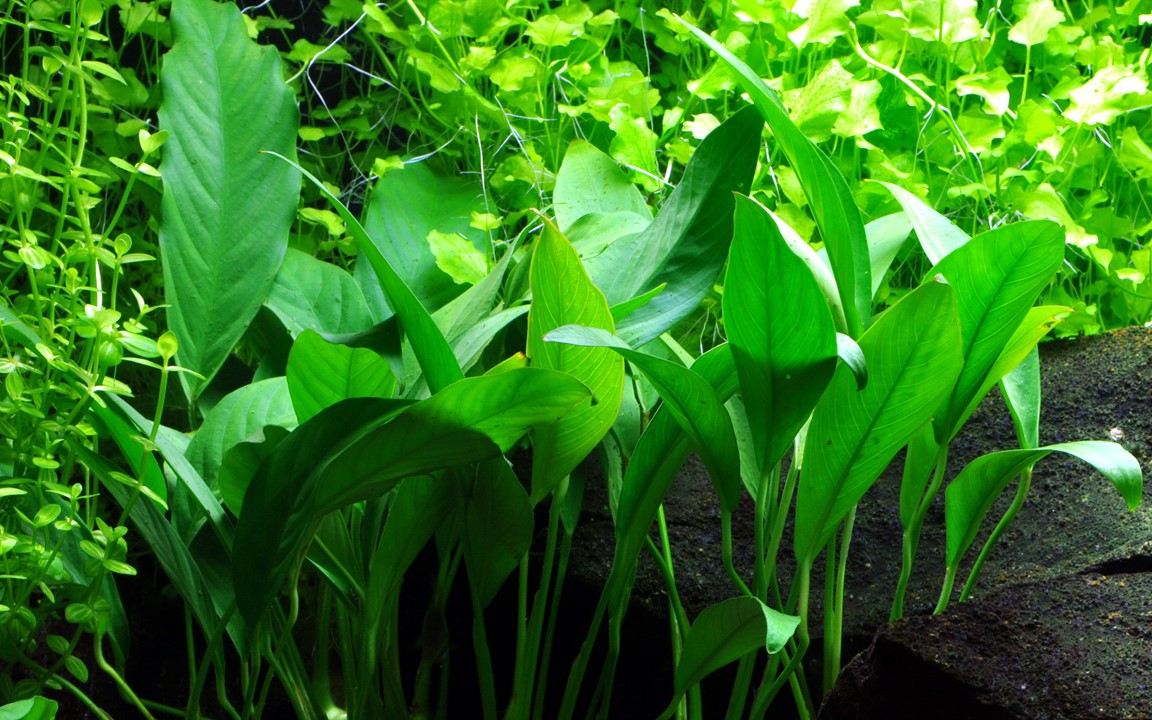
Anubias barteri var. angustifolia from West Africa is a beautiful plant with long, narrow leaves.
10-20 cm tall with a rhizome, from which the leaves develop, that grows 10-15 cm or larger. Very easy to grow since it thrives in almost any conditions, although high light intensity should be avoided. Place it instead in shady positions under larger plants. If planted in the bottom, do not cover the rhizome, it tends to rot. It is not eaten by herbivorous fish.
Anubias barteri var. angustifolia used to be sold as Anubias afzelii, but the latter is actually a much larger species. https://tropica.com/en/plants/plantdetails/Anubiasbarterivar.angustifolia(101C)/4552
Anubias barteri var. barteri Easy

Anubias barteri var. barteri from West Africa is an undemanding plant. It grows somewhat larger than Anubias barteri var. nana but is grown in the same conditions. From 25-45 cm tall and the creeping rhizome from 10-15 cm or more. Anubias barteri varies considerably in terms of size and leaf shape.
Like other Anubias-species, it is best planted in a shady spot to minimize algae growth on the leaves. If planted on the bottom, the rhizome must not be covered because it tends to rot. It is also suitable for terrariums and paludariums. Herbivorous fish do not eat the very tough and robust leaves. https://tropica.com/en/plants/plantdetails/Anubiasbarterivar.barteri(101A)/4551
Anubias barteri var. caladiifolia Easy

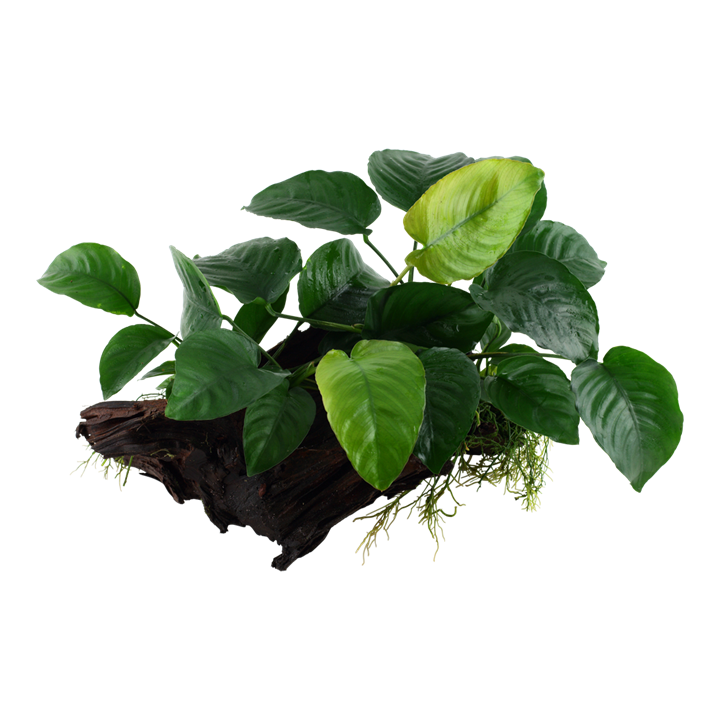
Anubias barteri var. caladiifolia originates from an Australian tissue propagation laboratory. It is a very beautiful variety with heart-shaped leaves. The leaves live for several years, so Anubias barteri var. caladiifolia can easily form large groups despite its slow growth. A group of Anubias barteri var. caladiifolia growing more than 50 cm wide in a few years is not unusual. https://tropica.com/en/plants/plantdetails/Anubiasbarterivar.caladiifolia(101U)/4556
Anubias barteri var. nana Easy

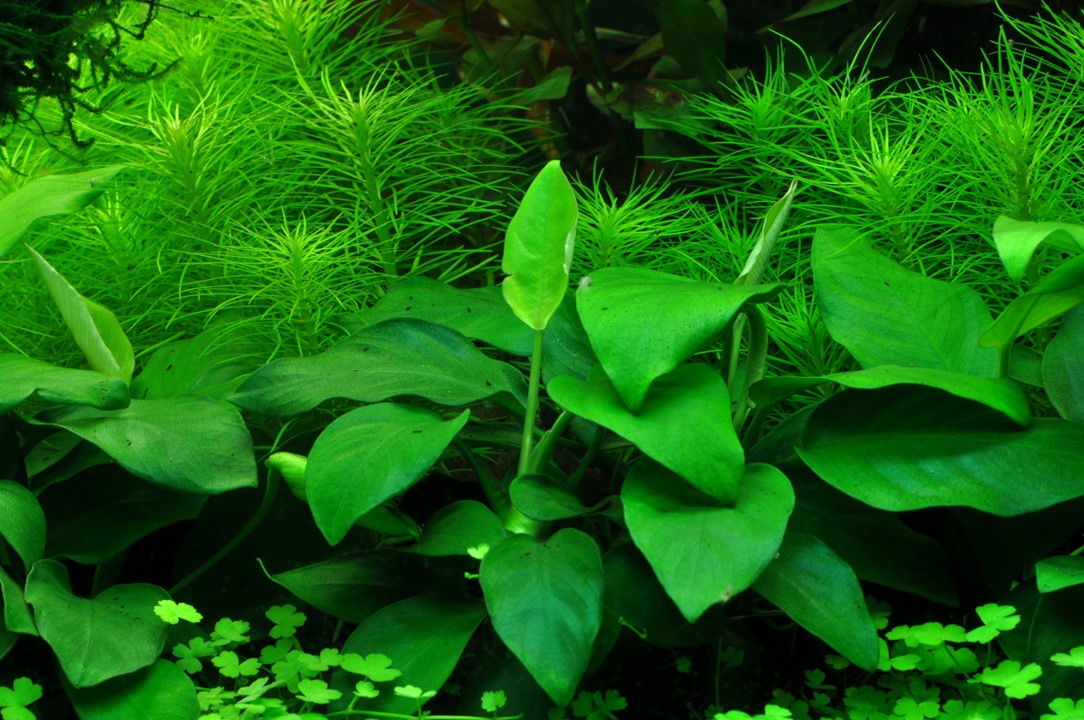
Anubias barteri var. nana is a small, attractive plant that thrives in all conditions.
It originates from Cameroon and will reach 5-10 cm height. The rhizome will be 10-15 cm or more. It grows slowly, and the leaves survive for several years, giving slow-growing algae the chance to become established. The best result is achieved by planting on a stone or tree root. Fishing line can be used to attach the plant until it gains a hold. If planted on the bottom the rhizome must not be covered because it tends to rot.
It flowers frequently under water and will thrive in shady places, where other plants will not. It is not eaten by herbivorous fish. https://tropica.com/en/plants/plantdetails/Anubiasbarterivar.nana(101)/4545
Anubias gracilis Easy


Western Africa is home to several species of Anubias, including this one.
The triangular leaves of 5-10 cm on long leaf-stems make Anubias gracilis one of the most elegant. It is hardy and tolerant, a very good beginner’s plant. The plant can grow on rock or wood or planted on the bottom. If planted in the bottom, the rhizome, from which leaves and roots appear, must not be covered. If it is, the whole plant will rot and die.
Anubias gracilis can be allowed to grow out of the water, but will attain a significant size this way. https://tropica.com/en/plants/plantdetails/Anubiasgracilis(101D)/17819
Aponogeton boivinianus Medium

Aponogeton boivinianus is a large, strong plant which is only suitable for large aquariums.
A bulb plant from Madagascar, whose bulb may be covered with the bottom layer, as long as the sprout tip is at the soil surface. In favorable conditions it can form very large leaves (up to 80 cm long and 8 cm wide, and from 30-50 cm wide). The oldest leaves are deep dark-green, while younger leaves are light-green and sometimes brownish until they are fully developed. Nutrition capsules enhances the growth considerably.
In the wild, Aponogeton boivinianus is found in fast-flowing water, and it prefers some flow in the aquarium water. It needs a dormant period when the bulb loses all its leaves, after which the growth will start again. https://tropica.com/en/plants/plantdetails/Aponogetonboivinianus(088KN)/4534
Aponogeton crispus Medium

Aponogeton crispus from Sri Lanka looks great in any aquarium with its light-green, wavy and transparent leaves. Leaves from 25-50 cm and the plant grows to 15-25 cm wide.
It makes few demands, although growth is always best in soft, slightly acidic water with a nutritious bottom. In such conditions the plant produces a mass of leaves, and it flowers very frequently in optimum conditions. Aponogeton crispus is generally found in ponds that are only filled with water in the rainy season, but it does not need a dormant period in the aquarium. https://tropica.com/en/plants/plantdetails/Aponogetoncrispus(083)/4531
Aponogeton longiplumulosus Medium
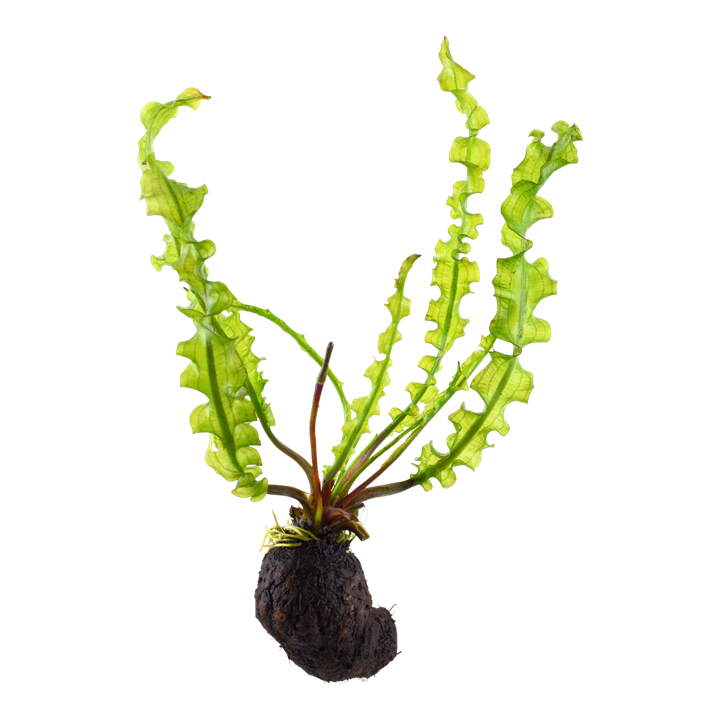

Aponogeton longiplumulosus from Madagascar has large, fluted leaves (35-60 cm long), making it a wonderful plant which can be recommended for large aquariums (the whole plant becomes 25-40 cm wide).
The bulb can be covered with the bottom layer, as long as the sprout tip is at the soil surface. It is relatively undemanding and makes no special demands on water quality. A Nutrition capsule placed under the bulb enhances the growth considerably. It also flowers frequently, making it a beautiful addition to any large open aquarium.
It stops growing at regular intervals, but normally starts again after a few weeks of dormancy. https://tropica.com/en/plants/plantdetails/Aponogetonlongiplumulosus(089DKN)/4536
Aponogeton madagascariensis Medium
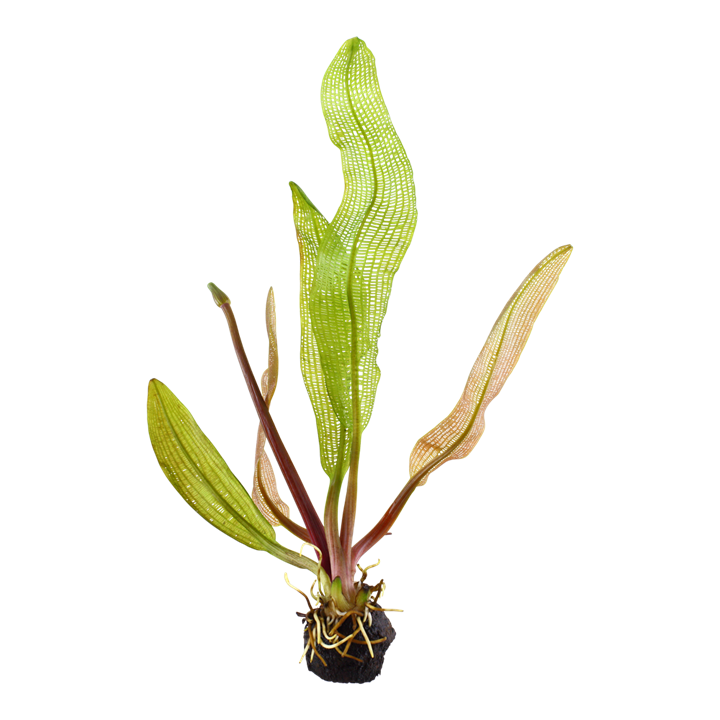
Aponogeton madagascariensis is a bulb plant from Madagascar and is a speciality in botanical gardens all over the world.
The bulb can be covered with the bottom layer, as long as the sprout tip is at the soil surface. Aponogeton madagascariensis makes such high demands on water quality and the bottom that it can only be recommended as a solitary plant in large, specialised aquariums in which the water is replaced frequently. Nutrition capsules enhances the growth considerably.
There are several varieties, with different structures and leaf widths, and sizes from 25-50 cm. https://tropica.com/en/plants/plantdetails/Aponogetonmadagascariensis(089KN)/4535
Aponogeton ulvaceus Medium

Aponogeton ulvaceus is one of the most beautiful bulb species in the Aponogeton-family and originates from Madagascar.
The leaves are delicate light-green and transparent with fluted margin. A single root can produce more than 40 leaves, 30-60 cm long. This means that the plant is best as a solitary plant in large aquariums (the plant becomes up to 50 cm wide). It is relatively tolerant, and thrives in both soft and hard water, particularly if CO2 is added.
There are many varieties of Aponogeton ulvaceus, some of which need a dormant period, when the root does not produce leaves. https://tropica.com/en/plants/plantdetails/Aponogetonulvaceus(086KN)/4533
Bacopa australis Medium



Bacopa australis was discovered in southern Brazil (australis = southern), and it is not from Australia, as might otherwise be assumed from its name. Stems become 10-30 cm tall and 2-4 cm wide. Like the other Bacopa species, Bacopa australis is also easy to grow in an aquarium. Under certain conditions it creeps across the bottom to form an elegant and decorative light green cushion. When Bacopa australis grows in a good light, the leaves become reddish. It is easily propagated by taking side shoots and planting them in the substrate. https://tropica.com/en/plants/plantdetails/Bacopaaustralis(043A)/4466
Bacopa caroliniana Easy



Bacopa caroliniana originates from US and has been used as an aquarium plant for many years. Stems become 10-30 cm long and 3-4 cm wide, branching willingly from the bottom. It has few demands and thus very convenient for beginners. Its slow growth rate makes it one of the few stem plants that do not need much attention. Like most stem plants, it is most decorative when planted in small groups. Easy to propagate by cuttings; take a side shoot and plant it in the bottom.
A bundle of stems or young plants gathered in an anchor. Remove the anchor and split into separate plants. Regarding stem plants, remove the leaves from the lowest 5 cm (2“). Remove any damaged leaves. Plant the individual plants with some distance into the bottom substrate. Roots will develop soon and the plant start growing. https://tropica.com/en/plants/plantdetails/Bacopacaroliniana(043)/4464
Bacopa monnieri ‘Compact’ Easy
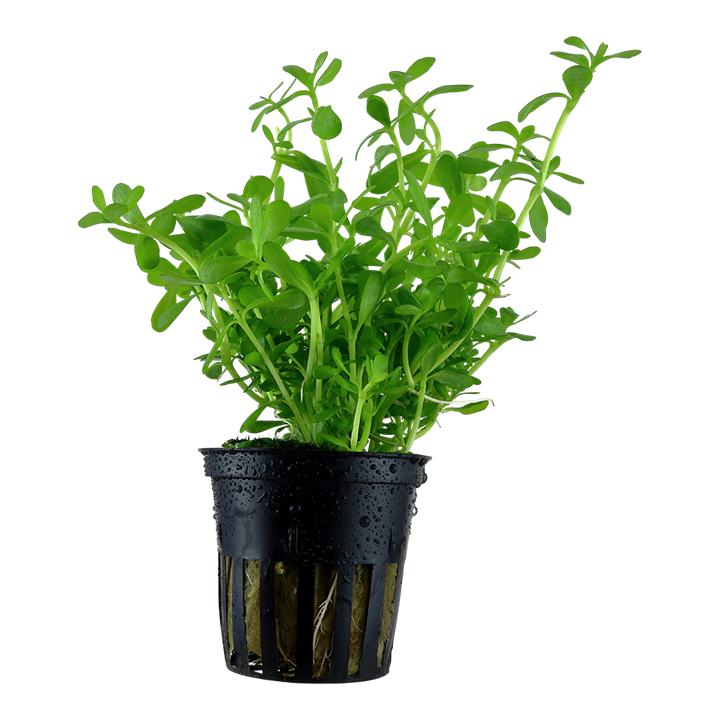

This culture form of the stalk plant Bacopa Monnieri is more compact and, under good light conditions, almost a creeping plant. By pinching off all vertical growing shoots, the plant can maintain a low and close growth, since it willingly creates a large number of side shoots.
Furthermore, the plant grows well in the shadow of other plants. Very suitable as a bit higher carpet – or bushy plant in the middle or front of the aquarium. The plant becomes more vertical growing and less compact without CO2 additive and decreased light conditions.https://tropica.com/en/plants/plantdetails/Bacopamonnieri’Compact'(044A)/4467
Blyxa japonica Medium
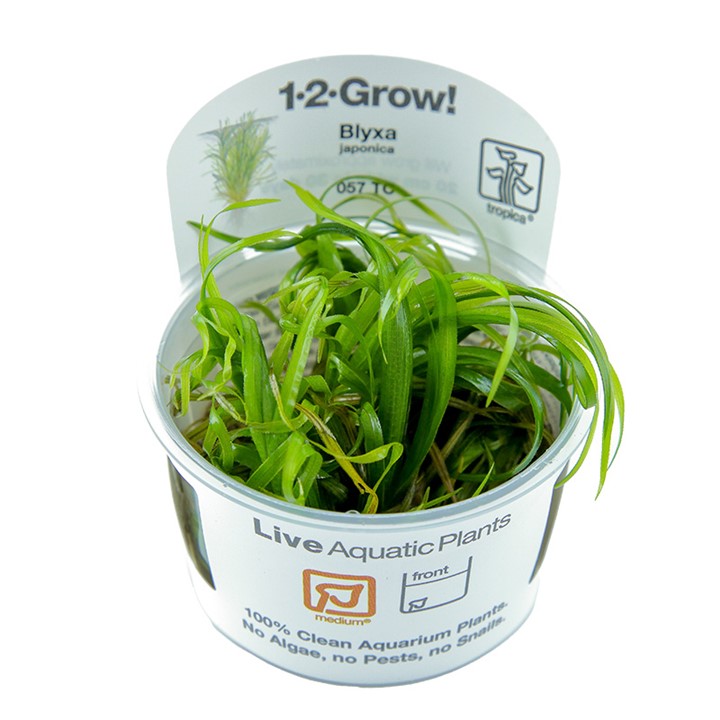


The Blyxa japonica originates in the nutrient rich shallow pools of water, swamps and slowly flowing rivers in East and South East Asia.
The plant has gained notoriety thanks to the late Takashi Amano and his aquarium works from the 90s.
Blyxa has a distinct grass-like appearance that moves easily in the circulating aquarium water creating a sense of dynamicity in comparison to other more robust plants. https://tropica.com/en/plants/plantdetails/Blyxajaponica(057TC)/22542
Bolbitis heudelotii Medium
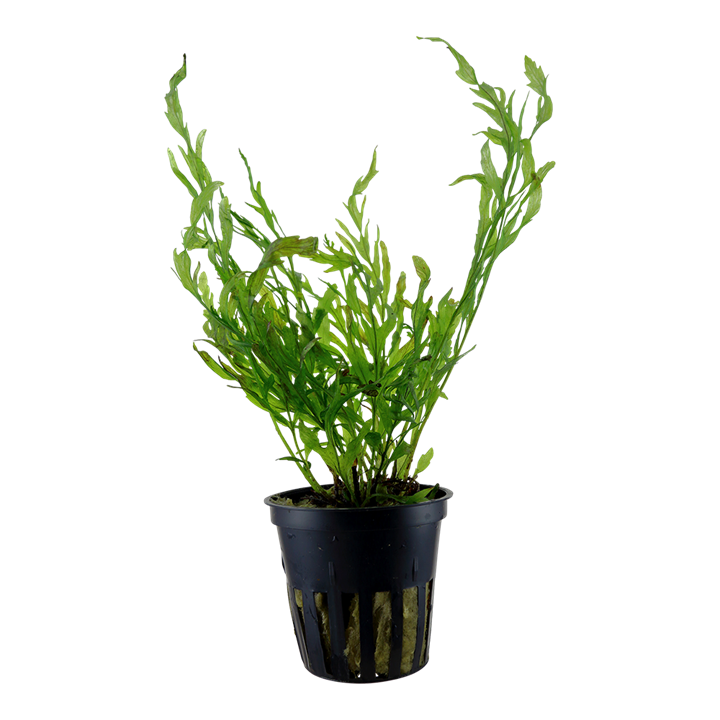


Bolbitis comes from West Africa, a fern with beautiful, transparent green leaves, 15-40 cm tall and wide. When planting do not cover the rhizome because it will rot, and it is best to plant Bolbitis heudelotii on a root or stone.
Easy to propagate by splitting the horizontal rhizome. Growth can be increased considerably by supplying CO2, and is only optimal in soft, slightly acidic water. https://tropica.com/en/plants/plantdetails/Bolbitisheudelotii(006)/4406
Bucephalandra ‘Kedagang’ Easy
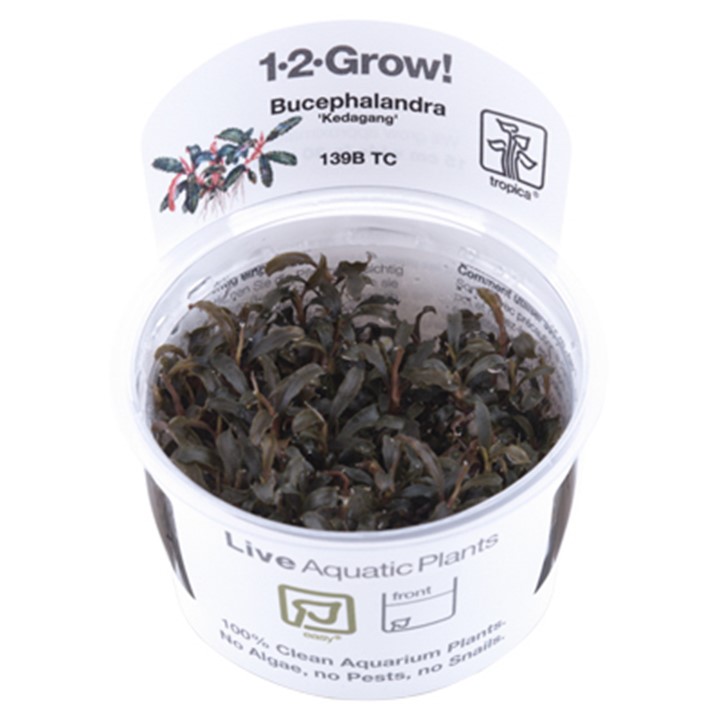


The ‘Kedagang’ is a variety of the Bucephalandra family originated in Borneo.
It is characterized by long, narrow, dark green leaves with white dots. The leaf can be 1-2 cm wide and up to 6 cm long.
The rhizomes are red and similar to the Red variety of Bucephalandra. When immersed, a blue metallic shade may appear on the leaves. https://tropica.com/en/plants/plantdetails/Bucephalandra’Kedagang'(139BTC)/22544
Bucephalandra pygmaea ‘Bukit Kelam’ Easy


In nature, Bucephalandra usually grows on rocks or wood in rivers and streams – much like Anubias, which they resemble regarding use and care in the aquarium.
Bucephalandra ‘Bukit Kalem’ is an easy, slow-growing plant that prefers lower light levels. A nice, dense appearance is ensured by the willingness to branch, even without trimming.
The green leaves are 2 cm wide and 5 cm long with wavy edges. Tiny white spots will appear on immerse leaves.
The creeping stem, rhizome, must not be covered when planting. This will cause the plant to rot and die. https://tropica.com/en/plants/plantdetails/Bucephalandrapygmaea’BukitKelam'(139TC)/28393
Bucephalandra sp. ‘Red’ Easy


Red Bucephalandra varieties, potted.
The Bucephalandra resemble Anubias very much and should be treated the same way. They usually grow more or less epiphytic in or near water.
Bucephalandra sp. ‘Red’ does best at lower light levels and is very easy to grow. The leaves are of a very dark green or leathery red colour. Numerous tiny, white dots and sometimes a faint, metallic, blue colour will appear on submerse leaves. Size of leaf is 2-4 cm wide, 4-6 cm long and usually it will present wavy edges.
Do not cover the creeping rhizome when planting. This will cause the plant to rot and die. https://tropica.com/en/plants/plantdetails/Bucephalandrasp.’Red'(139A)/19682
Bucephalandra pygmaea ‘Wavy Green’


In nature, Bucephalandra usually grows on rocks or wood in rivers and streams – much like Anubias, which they resemble regarding use and care in the aquarium.
Bucephalandra ‘Wavy Green’ is an easy, slow-growing plant that prefers lower light levels. A nice, dense appearance is ensured by the willingness to branch, even without trimming.
The green leaves are 2 cm wide and 5 cm long with wavy edges. Tiny white spots will appear on immerse leaves.
The creeping stem, rhizome, must not be covered when planting. This will cause the plant to rot and die. for inspiration see https://tropica.com/en/inspiration/layout/Layout108/21195
Cabomba aquatica Easy
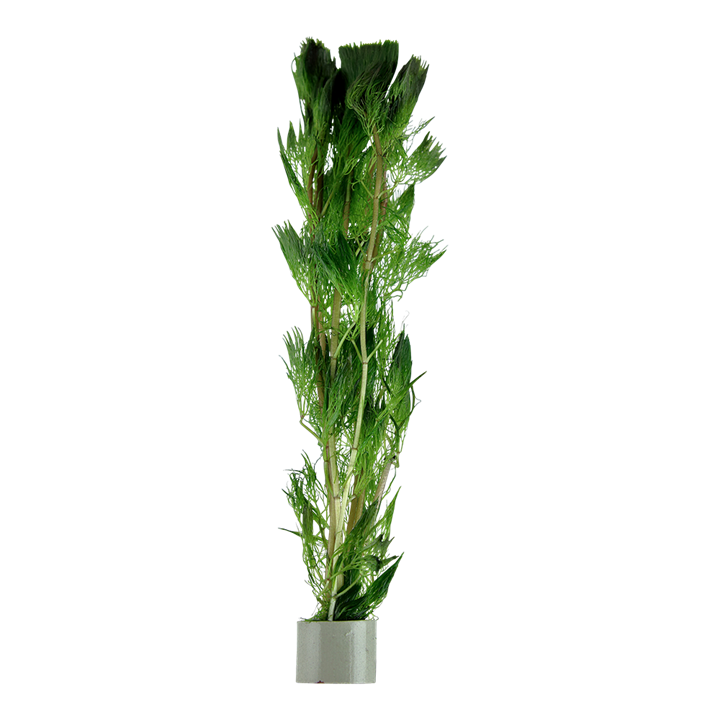


Cabomba is a very popular aquarium plant from South America owing to its beautiful foliage. It reaches 30-80 cm and each stem can become 5-8 cm wide. The least demanding of the Cabomba-species, but still causes problems in poorly lit aquariums. If there is not sufficient light, try Limnophila sessiliflora, which requires less light. Most decorative when planted in groups.
Eaten locally as a vegetable.
A bundle of stems or young plants gathered in an anchor. Remove the anchor and split into separate plants. Regarding stem plants, remove the leaves from the lowest 5 cm (2“). Remove any damaged leaves. Plant the individual plants with some distance into the bottom substrate. Roots will develop soon and the plant start growing. https://tropica.com/en/plants/plantdetails/Cabombaaquatica(015BDT)/4431
Cardamine lyrata Easy

Cardamine lyrata is actually a marsh plant from Japan. But it is also a familiar aquarium plant which thrives under water with 20-50 cm long stems. A characteristic trailing growth form makes it highly decorative, and ‘aerial’ roots often form on the plant itself.
Plant it in groups, and make sure the water temperature does not exceed 28 degrees C (this makes the leaves much smaller and the plant more leggy). Also suitable in garden ponds in the summer. https://tropica.com/en/plants/plantdetails/Cardaminelyrata(024)/4441
Ceratophyllum demersum ‘Foxtail’ Easy
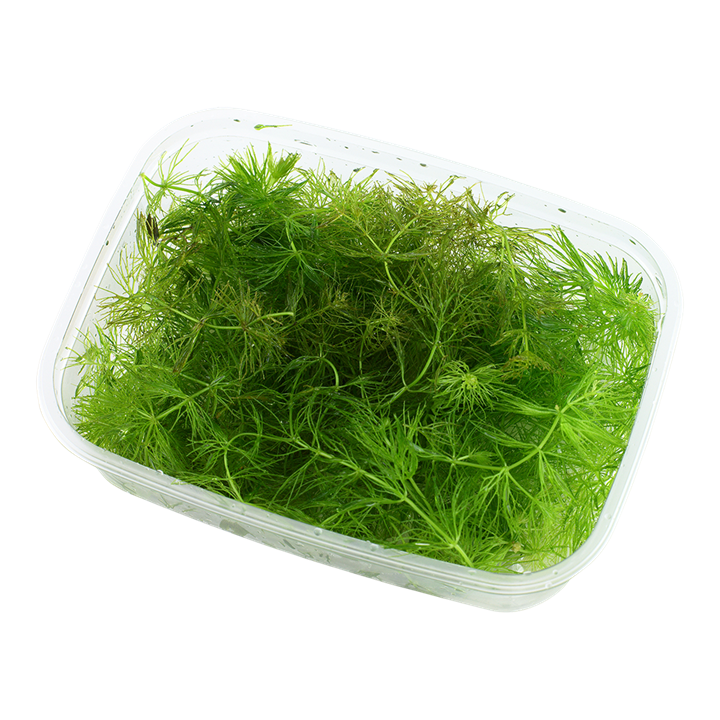


Ceratophyllum demersum ‘Foxtail’ was found in a smaller tributary in Bolivia during an expedition to Rio Guapore, a boundary river between Brazil and Bolivia. Ceratophyllum has no roots as such, but it is nevertheless possible to plant it in the bottom of an aquarium and stems can become up to 80 cm tall and 5 cm wide. ‘Foxtail’ differs because its leaves are closer together and it has lateral shoots, which gives it an attractive, compact appearance.
The plant also distinguishes itself because it is hardier and its stalks do not break as easily as those of other Ceratophyllum-varieties. https://tropica.com/en/plants/plantdetails/Ceratophyllumdemersum’Foxtail'(021APOR)/4434
Ceratopteris thalictroides Medium


Ceratopteris thalictroides is a pantropical fern, 15-30 cm high and 10-20 cm wide..
This plant normally grows fast, but the addition of CO2 may be necessary to promote growth. In small, open aquariums, it can grow out of the tank and form beautiful surface leaves. The finely branched leaves are very decorative and provide good contrast to other leaf shapes. In good light Ceratopteris thalictroides grows fast and helps prevent algae by consuming large amounts of nutrients. This makes it a good starter plant in small aquariums. https://tropica.com/en/plants/plantdetails/Ceratopteristhalictroides(005A)/4405
Crinum calamistratum Easy


Crinum calamistratum from West Africa is a very graceful bulbous plant with dark-green, very narrow leaves. The curly leaves becomes 40-120 cm long. It forms smaller bulbs than the other Crinum-species, and requires less light.
In the aquarium plants that are thriving form a number of small bulbs. It is not eaten by herbivorous fish. It can also be used in brackish aquariums with low salt concentrations. https://tropica.com/en/plants/plantdetails/Crinumcalamistratum(094A)/4541
Crinum thaianum Easy


Crinum thaianum from Thailand is a distinctive bulbous plant belonging to the lily family having 60-200 cm long leaves. It is undemanding apart from the fact that it needs plenty of space. Plant so the top 2/3 of the bulb is visible, because otherwise the bulb tends to rot. When the plant grows older it sometimes sends a flower stem up to the water surface with an aromatic, elegant lily flower. https://tropica.com/en/plants/plantdetails/Crinumthaianum(093)/4537
Cryptocoryne albida ‘Brown’ Easy


This little Cryptocoryne comes from Asia, and grows naturally in for instance Thailand.
The narrow, red-brown leaves have clear, black patterns and beautifully waving leaf edges. Each leaf grows to be about 1-3 cm wide and up to 15 cm long, giving the plant a light and graceful look, which is easy to combine with other plants inside the aquarium, enabling beautiful contrasts.
Like many other Cryptocorynes, it is able to grow under must conditions and can thrive at even very poor light conditions. However, it will only grow very slow under such conditions. https://tropica.com/en/plants/plantdetails/Cryptocorynealbida’Brown'(126B)/18194
Cryptocoryne beckettii ‘Petchii’ Easy

Cryptocoryne beckettii ‘Petchii’ is a small variety of Cryptocoryne beckettii from Sri Lanka, which has beautiful, slightly fluted leaf margins, 10-15 cm long. Leaves become dark olive-brown with violet underside. Like many other Cryptocorynes, the leaf colour and shape depends largely on environmental conditions in the aquarium. https://tropica.com/en/plants/plantdetails/Cryptocorynebeckettii’Petchii'(108A)/4560
Cryptocoryne crispatula Easy



Aquarium plant from tissue culture in closed cup.
Cryptocoryne crispatula var. balansae is from the limestone mountains of Southern Thailand, where the water can be very hard. It is not very demanding, but appreciates a nutritious substrate and good light. Like many other Cryptocorynes it needs to acclimatize before growth starts in earnest.
Leaves becomes 20-60 cm long and the single roset plant becomes 15-20 cm wide. Place it in the rear part of the tank, from where the leaves may float beautifully on the water surface. The leaves are either entirely green or maroon. https://tropica.com/en/plants/plantdetails/Cryptocorynecrispatula(125TC)/18756
Cryptocoryne parva Medium




Cryptocoryne parva fromac Sri Lanka is the smallest of all Cryptocorynes (only 3-6 cm tall and a roset less than 5-8 cm wide). It is one of the few species that does not significantly change its leaf shape and colour depending on cultivation conditions. It needs more light than most other Cryptocorynes because it almost loses its leaf plate under water. So, it must never be overshadowed by other plants.
Known for its slow growth, but Nutrition Capsules in the bottom layer will enhance the development. Individual plants should be planted a few centimetres apart, and after about six months they will form a cohesive low group of plants.
Very recommendable foreground plant. https://tropica.com/en/plants/plantdetails/Cryptocoryneparva(106TC)/18755
Cryptocoryne undulata ‘Broad Leaves’ Easy


The triploid variety of Cryptocoryne undulata from Sri Lanka has wider leaves and a beautiful, flecked leaf pattern.
It also grows larger, from 15-30 cm, and the single roset becomes 10-20 cm wide. It is a hardy plant and do well under many growing conditions. https://tropica.com/en/plants/plantdetails/Cryptocoryneundulata’BroadLeaves'(110A)/4566
Cryptocoryne undulatus ‘Red’ Easy


Aquarium plant from tissue culture in closed cup.
This red version of Cryptocoryne undulata grows wild in rivers of Sri Lanka.
It is an easy plant, tolerant of very different conditions in an aquarium. Appearance of the plant will partially depend on these conditions.
Low levels of light and nutrients will produce a relatively tall, greenish-brown plant of slow growth. Higher levels of light and nutrition, combined with added CO2, will make the plant grow considerably faster producing shorter leaves of a reddish-brown colour. https://tropica.com/en/plants/plantdetails/Cryptocoryneundulatus’Red'(110BTC)/19225
Cryptocoryne usteriana Easy


Cryptocoryne usteriana is one of the taller cryptocorynes and is very easy to grow.
Leaves are 3-5 cm wide with an embossed surface; they can easily reach more than 50 cm length.
With good light and fertilization, the upper side of the leaves will obtain a dark green or bronze-green colour while the back of the leaves will turn burgundy red.
Propagation is by long runners, and the plant tolerates quite alkaline water very well. https://tropica.com/en/plants/plantdetails/Cryptocoryneusteriana(120)/18405
Cryptocoryne wendtii ‘Green’ Easy
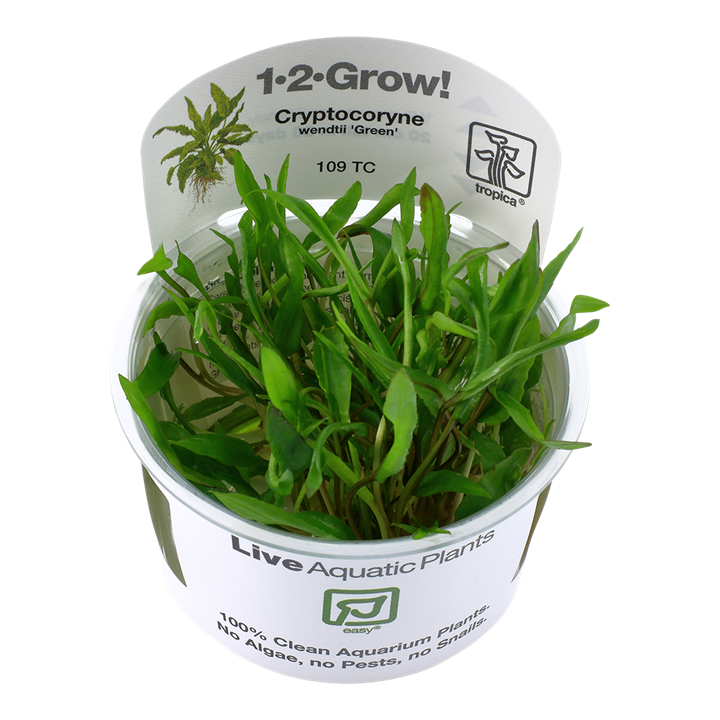


Aquarium plant from tissue culture in closed cup.
Cryptocoryne wendtii ‘Green’ presents beautiful, green leaves. Depending on your aquarium setup wendtii ‘Green’ can reach a height of 10-30 cm with rosets ranging from 8-15 cm wide.
When grown in an open space the leaves will virtually lie on the bottom. Like most other Sri Lanka Cryptocorynes, it also grows well in hard water.
Easy to grow, it thrives in almost all conditions, even in the shadow of larger plants.
A fresh green group of Cryptocoryne wendtii ‘Green’ will decorate any tank. https://tropica.com/en/plants/plantdetails/Cryptocorynewendtii’Green'(109TC)/19226
Cryptocoryne wendtii ‘Tropica’ Easy


Large motherplant, grown in a 9 cm square pot.
This beautiful variety with the dark, hammered leaves is named after ‘Tropica’. When grown in an open space the leaves will virtually lie on the bottom. It is suitable for small aquariums with leaves from 10-20 cm, and a rosette from 10-20 cm wide. Like most other Sri Lanka Cryptocorynes, it also grows well in hard water. https://tropica.com/en/plants/plantdetails/Cryptocorynewendtii’Tropica'(109EXL)/4565
Cryptocoryne x willisii Easy


This Cryptocoryne from Sri Lanka used (mistakenly) to be called Cryptocoryne nevillii, but this is the name of a species that has never been used in aquariums. Like many other Cryptocorynes, not much happens the first month after planting. But then it starts to grow, and willingly produces plenty of runners which form a compact group. The plant becomes 7-20 cm tall, and each roset 7-15 cm wide. https://tropica.com/en/plants/plantdetails/Cryptocorynexwillisii(107)/4559
Cyperus helferi Medium


Cyperus-species are widespread all over the tropics, but only a few of them are good underwater plants. Cyperus helferi from Thailand is the first Cyperus-species used in aquariums, 20-35 cm tall and a roset from 15-25 cm wide. It requires a relatively large amount of light, and CO2 addition is recommended to promote growth. In aquariums with good water flow the plant sways beautifully in the current. https://tropica.com/en/plants/plantdetails/Cyperushelferi(133A)/4574
Echinodorus ‘Aquartica’ Medium

Characteristics of the cultivar Echinodorus ‘Aquartica’ are its round, bright green leaves. Its compact (10-20 cm), low growth makes it suitable as a decorative solitary plant.
Slow growing and easy to care for, Echinodorus ‘Aquartica’ retains the refreshing green colour of its leaves in normal lighting and nutrient conditions in the aquarium. The plant is a cross between several different cultivated plants, including Echinodorus horemanii and several round-leafed Echinodorus species. Echinodorus ‘Aquartica’ was developed by Kristian Iversen from the “Aquartica” company. https://tropica.com/en/plants/plantdetails/Echinodorus’Aquartica'(074F)/4526
Echinodorus ‘Barthii’ Easy

Large motherplant, grown in a 9 cm square pot.
The cultivar Echinodorus ‘Barthii’ is a decorative and beautiful solitary plant for large aquariums. It becomes 25-50 cm tall and the whole rosette 20-30 cm wide.
The leaves change colour from dark-red in the youngest leaves to dark-green in the oldest. The colour develops well when the light intensity is high and there are sufficient micronutrients in the aquarium. A nutritious bottom and CO2 addition promote growth. This plant takes a lot of light from plants underneath, so it must be pruned occasionally.
It used to be sold as “Double Red”. https://tropica.com/en/plants/plantdetails/Echinodorus’Barthii'(072AXL)/4515
Echinodorus cordifolius ‘Fluitans’ Easy

A comparatively fast-growing Echinodorus from Mexico, suitable for large aquariums reaching 20-50 cm long leaves and a 15-30 cm wide roset. Easy and undemanding, excellent plant for beginners.
Its wavy, light green leaves are very decorative. Unlike other round-leafed varieties of the species, Echinodorus cordifolius fluitans is less likely to grow up over the water surface. If it grows large enough, it forms large leaves just under the surface instead. https://tropica.com/en/plants/plantdetails/Echinodoruscordifolius’Fluitans'(073D)/4519
Echinodorus grisebachii ‘Bleherae’ Easy
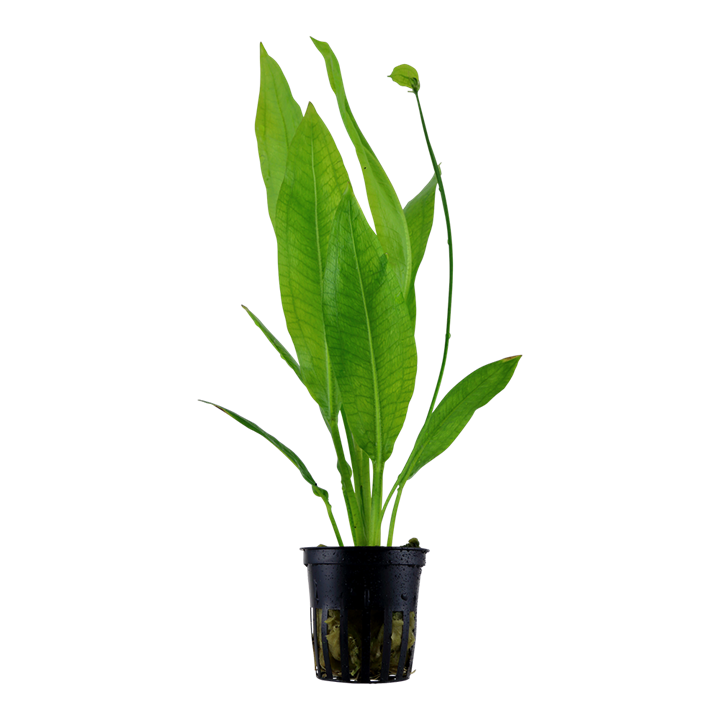

Echinodorus bleheri from South America is undemanding and beautiful, and becomes 20-50 cm tall.
A nutritious bottom promotes growth, but the plant needs pruning to prevent it depriving plants underneath of light. Echinodorus bleheri does well even in poorly illuminated aquariums, as it grows towards the light.
It is a hardy and easy solitary plant for both beginners and the more experienced with quite large aquariums. It has been sold under the name “Paniculatus”.
A bundle of stems or young plants gathered in an anchor. Remove the anchor and split into separate plants. Regarding stem plants, remove the leaves from the lowest 5 cm (2“). Remove any damaged leaves. Plant the individual plants with some distance into the bottom substrate. Roots will develop soon and the plant start growing. https://tropica.com/en/plants/plantdetails/Echinodorusgrisebachii’Bleherae'(071BDT)/4513
Echinodorus ‘Ozelot’ Easy

Echinodorus ‘Ozelot’ is a decorative hybrid between Echinodorus schluteri ‘Leopard’ and Echinodorus ‘Barthii’. 20-50 cm tall and a 20-40 cm wide rosette.
Naturally, it is the elliptical black spots on the red-brown leaves that have given this plant the name ‘Ozelot’. The spots are darkest on the youngest leaves, and unlike many other spotted Echinodorus, ‘Ozelot’ retains its spots even at low light intensity.
It is an undemanding and good plant for beginners. https://tropica.com/en/plants/plantdetails/Echinodorus’Ozelot'(073F)/4520
Echinodorus ‘Ozelot Green’ Easy

A beautiful, dark-green variety of Echinodorus ‘Ozelot’, 20-50 cm tall and a 20-40 cm wide rosette.
The dark spots form a bigger contrast on the light leaves. The leaf margin is fluted. A nutritious bottom promotes growth. It is an easy and highly recommended plant, which thrives in almost all conditions. https://tropica.com/en/plants/plantdetails/Echinodorus’OzelotGreen'(073G)/4522
Echinodorus palifolius Medium

In marshy conditions, Echinodorus palaefolius var. latifolius from Brazil has round leaves with a horizontal leaf base. Under water the leaves are narrower and longer (from 20-40 cm, and a 20-40 cm wide roset).
In the aquarium it tends to grow out of the water. This can be prevented by removing the long leaves just before they reach the water surface. The next leaves will then become shorter and the plant will remain under water. In open aquariums the plant can be allowed to grow out of the water, but the leaf margins often dry out if air humidity is low. https://tropica.com/en/plants/plantdetails/Echinodoruspalifolius(076)/4527
Echinodorus ‘Red Diamond’ Medium

Echinodorus ‘Red Diamond’ appeared as a culture in the Ukraine, and is probably a cross between Echinodorus horemanni ‘Red’ and Echinodorus ‘Barthii’. The resultant hybrid is an attractive plant with ruby-red sword-shaped leaves, 15-25 cm long.
Unlike many of the other Echinodorus-species, Echinodorus ‘Red Diamond’ remains moderate in size (20-30 cm wide roset), so it is extremely well suited as a solitary plant, even in small aquariums. Increasing the nutrients in the substrate results in more abundant growth, while favourable light conditions promote the formation of the ruby-red leaves. https://tropica.com/en/plants/plantdetails/Echinodorus’RedDiamond'(074D)/4525
Echinodorus ‘Reni’ Easy


Aquarium plant from tissue culture in closed cup.
‘Reni’ is a well-known cultivar characterised by being amongst the smallest of the red Echinodorus, 15-40 cm tall and a roset from 15-25 wide. The new leaves of the plant are reddish-brown to deep beetroot in colour. It can be used in small aquariums and is unpretentious. The plant requires a lot of light and nourishment for optimal colour development. https://tropica.com/en/plants/plantdetails/Echinodorus’Reni'(072DTC)/18754
Echinodorus ‘Rosé’ Easy

This beautiful plant is a hybrid between Echinodorus horemanii ‘Red’ and Echinodorus horizontalis.
It was first produced in 1986 by Hans Barth in Dessau and becomes 25-40 cm tall and a rosette from 15-25 cm wide. New underwater leaves are a beautiful pink, and initially the leaves have red-brown spots. A nutritious bottom promotes growth, but otherwise Echinodorus ‘Rosé’ is undemanding and thus an excellent plant for beginners. https://tropica.com/en/plants/plantdetails/Echinodorus’Rosé'(072B)/4516
Egeria densa Easy


The cosmopolitan Egeria densa anacharus is a good plant for beginners, and its rapid growth helps create a balance in the aquarium from the start. Stems grows fast to 40-100 cm and becomes 2-4 cm wide. Egeria helps preventing algae because it absorbs a great number of nutrients from the water.
The growth rate depends largely on the amount of light and nutrition available. Growth does not stop in unfavourable conditions, but the plant turns light in colour and the tendrils grow thin.
A bundle of stems or young plants gathered in an anchor. Remove the anchor and split into separate plants. Regarding stem plants, remove the leaves from the lowest 5 cm (2“). Remove any damaged leaves. Plant the individual plants with some distance into the bottom substrate. Roots will develop soon and the plant start growing. https://tropica.com/en/plants/plantdetails/Egeriadensa(058BDT)/4506
Elatine hydropiper Advanced


The creeping growth of this stem-plant makes it highly attractive for creating carpets in the aquarium. The very small leaf size makes it an obvious choice for nano-tanks.
Its fresh green colour compliments wood, rocks and other plants extraordinary well and has made the plant increasingly popular.
The growth of Elatine hydropiper is quite similar to Hemianthus callitrichoides ‘Cuba’ and Glossostigma elatinoides but is considerably slower, making it easier to maintain. https://tropica.com/en/plants/plantdetails/Elatinehydropiper(141TC)/18759
Eleocharis acicularis Easy

Eleocharis acicularis is very common and thrives in almost all conditions in an aquarium. An open space without shading from other plants is still preferable.
After planting, the roots will start colonizing the surroundings, creating a beautiful carpet of 6-15 cm height. If the carpet grows too tall, you may carefully cut it back to the preferred height. https://tropica.com/en/plants/plantdetails/Eleocharisacicularis(133TC)/28401
Eleocharis acicularis ‘Mini’ Medium


Aquarium plant from tissue culture in closed cup.
Eleocharis acicularis ‘mini’ has even lower growth than the common Eleocharis parvula and was given to Tropica by Thomas Barr from USA. Plant the mini-version in small portions to cover a large area. In short time, a dense carpet will be obtained. Needs light to perform optimally, however, it is one of the most reliable species for creating a carpet – and a minimum of maintenance since the leaves remain short (3-5 cm). Suitable for nano-aquariums. https://tropica.com/en/plants/plantdetails/Eleocharisacicularis’Mini'(132BTC)/4571
Eleocharis montevidensis Easy


This American Eleocharis has a fresh grass green colour and grows to be 20-40cm high. It is basic and low maintenance. Each straw is only few millimeters thick and the plant maintains an open form of growth. It is suitable as a background plant, and can further be planted in front and in the centre of the aquarium, in transparent wads, in order to create depth and perspective. The plant spreads through runners, which occasionally have to be trimmed and maybe planted elsewhere. https://tropica.com/en/plants/plantdetails/Eleocharismontevidensis(132D)/4573
Eleocharis parvula Easy

A low-growing Eleocharis that forms runners close to the parent plant. It is prettiest planted in small bunches quite close to each other, which will gradually form a solid mass of plants. An ideal foreground plant, equally suited to large and small aquariums. https://tropica.com/en/plants/plantdetails/Eleocharisparvula(132C)/4572
Eriocaulon cinereum Advanced


Aquarium plant from tissue culture in closed cup.
The genus Eriocaulon is usually adapted to soft water. Eriocaulon cinereum is more tolerant than most and will thrive in medium-hard water. Soft water will promote overall health.
This is a quite small, very narrow-leaved and almost cushion-growing plant, that demands good supply of light and CO2 to develop.
The plant usually flowers very willingly after planting in the aquarium and the numerous flower stems give a unique appearance.
Flowering easily drains the energy of the plant, but given the right conditions, it will gather new energy and grow from basis after some time. https://tropica.com/en/plants/plantdetails/Eriocauloncinereum(091TC)/19547
Fissidens fontanus Advanced



This featherlike Fissidens-moss with tight deep green down comes from North America. It grows relatively slow and requires much more light than other mosses. Suitable for attaching to wood pieces or rocks both vertically and horizontally in the aquarium. https://tropica.com/en/plants/plantdetails/Fissidensfontanus(002F)/4390
Glossostigma elatinoides Advanced
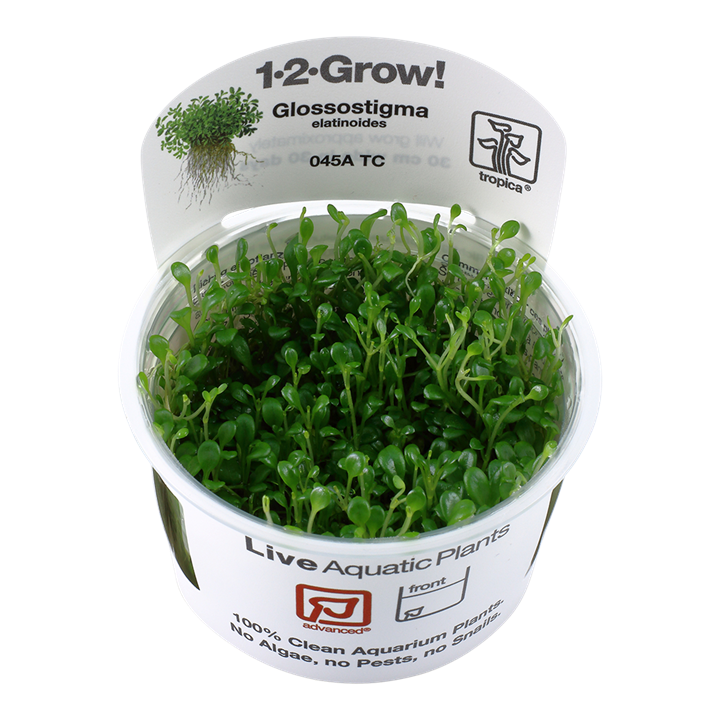


Glossostigma elatinoides from New Zealand is much in demand in Japanese-inspired aquariums. It is one of the smallest aquarium plants (2-3 cm tall), and thus a good foreground plant. A difficult plant demanding a lot of light. Grows upwards if light is poor. Make sure larger plants do not overshadow it. When planting in the aquarium small clumps (approx. 1/8 pot) should be placed at intervals of a few centimetres to help the plants grow together more quickly. CO2 addition and soft water promote growth significantly. https://tropica.com/en/plants/plantdetails/Glossostigmaelatinoides(045ATC)/4470
Gratiola viscidula Medium


Gratiola viscidula originates from Northern America and is relatively new to the aquatic hobby. The somewhat ‘thorny’ appearance of the submersed form makes it very distinct and easily recognizable.
It is quite easy to grow and prefers good light. By regular trimming it can be kept very low, almost carpeting, but will also present itself well as a fore/mid-ground cushion-plant.
Each stem is approximately 1-2 cm wide and can become 10+ cm tall. The stem willingly branches and spreads giving a very dense appearance to the plant. https://tropica.com/en/plants/plantdetails/Gratiolaviscidula(042TC)/18390
Helanthium bolivianum ‘Quadricostatus’ Easy



Helanthium ‘Quadricostatus’ from South America has characteristic light green leaves 10-15 cm long which offer a great contrast to the darker aquarium plants. It is most beautiful when planted in groups, each rosette becoming 15-20 cm wide. Thrives well even at a rather low light.
In good conditions, it produces runners which spread over the bottom. Very pale leaves are a sign of a shortage of micro-nutrients. There is some confusion about the name of this plant, and it has been sold as Echinodorus bolivianus var. magdalenensis.
Previously known as Echinodorus ‘Quadricostatus’. https://tropica.com/en/plants/plantdetails/Helanthiumbolivianum’Quadricostatus'(068TC)/18896
Helanthium tenellum ‘Green’ Easy


Previously named Echinodorus tenellus ‘Green’.
Previously named Echinodorus tenellus ‘Green’.
This small rosulate plant will easily make a 5-10 cm high carpet when the light is good and the bottom layer nutritious. Even at an intense light level this variety remains fresh green unlike the usual, more reddish, Helanthium tenellum.
An easy and quite undemanding foreground plant. https://tropica.com/en/plants/plantdetails/Helanthiumtenellum’Green'(067ATC)/4757
Hemianthus callitrichoides ‘Cuba’ Advanced



Hemianthus callitrichoides is one of the smallest aquarium plants in the world, and creeps over the bottom with millimetre-sized, round leaves. Hemianthus callitrichoides is an attractive and popular foreground plant for small aquariums.
It is not a difficult plant, but it requires good conditions such as enough light, added CO2, water circulation and fertilizer to thrive. If these conditions are hard to create, you may use Micranthemum ‘Monte-Carlo’ as an alternative, as it is less demanding.
Small pearls or bubbles of oxygen are often produced on top of the plants, adding a very lively aspect to the carpet.
If planted in small clumps a few centimetres apart, it will spread rapidly and cover the bottom like a carpet. Trim the carpet regularly, otherwise the lower parts will not get enough light causing root death.
Found on Cuba, west of Havana. https://tropica.com/en/plants/plantdetails/Hemianthuscallitrichoides’Cuba'(048BTC)/4478
Hemianthus micranthemoides Advanced

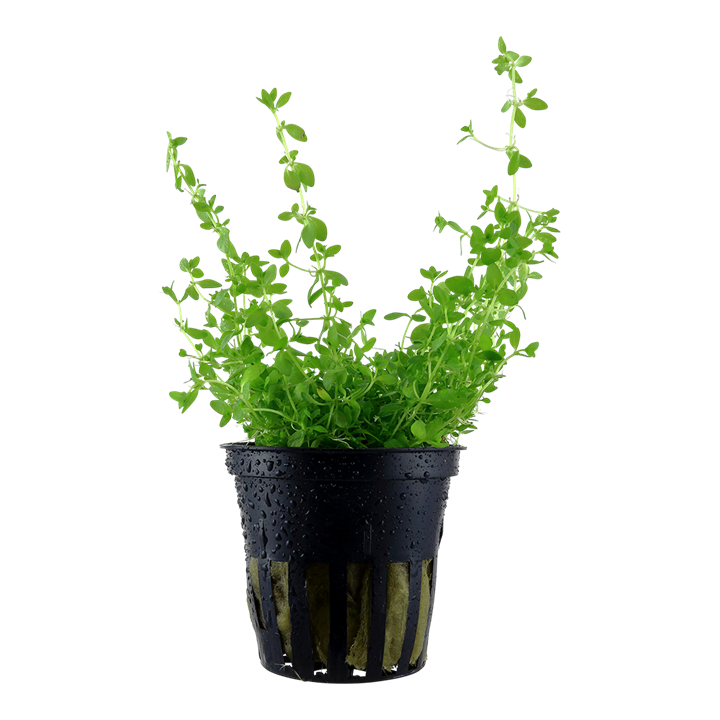

Hemianthus micranthemoides from North America is a graceful plant whose small, arched leaves make it look like a miniature version of Egeria. It has a characteristic trailing growth in intensive light, so it can be used as a foreground plant (stems from 10-20 cm tall, 2-3 cm wide). A compact group of Hemianthus micranthemoides is very beautiful with its small, light-green leaves.
In terrariums the plant forms a compact cushion.
Used to be called Micranthemum micranthemoides. https://tropica.com/en/plants/plantdetails/Hemianthusmicranthemoides(048ATC)/22879
Heteranthera zosterifolia Easy


Heteranthera zosterifolia from South America is an extremely beautiful plant, which forms a lot of side shoots and thus quickly forms a bushy plant group.
Stems can become 30-50 cm tall and 6-12 cm wide. Leaves often become black on the back. In strong light growth is intensive, and the plant must be pruned before it becomes so compact that no light reaches the lower leaves. Water roots often form on the stem. Those are easily cut and replanted.
In open aquariums, it forms small blue flowers if some shoots are allowed to spread on the surface. https://tropica.com/en/plants/plantdetails/Heterantherazosterifolia(096TC)/4544
Hottonia palustris Easy



The stem plant Hottonia from Asia and Europe is an unassuming and easy beginner plant. The many curved shoots with fanned and intensely light green leaves quickly create a close group. Each stem becomes 4-6 cm wide and 10-30 cm high. Frequent cutting of the long shoots ensures growth from the bottom of the plant, and maintains the close, bushy form.
The plant’s wide form of growth makes it very suitable for the passage between very low and tall plants. The bright green colour creates beautiful contrast and will enhance the shades of surrounding red plants. https://tropica.com/en/plants/plantdetails/Hottoniapalustris(027TC)/28508
Hydrocotyle tripartita Medium
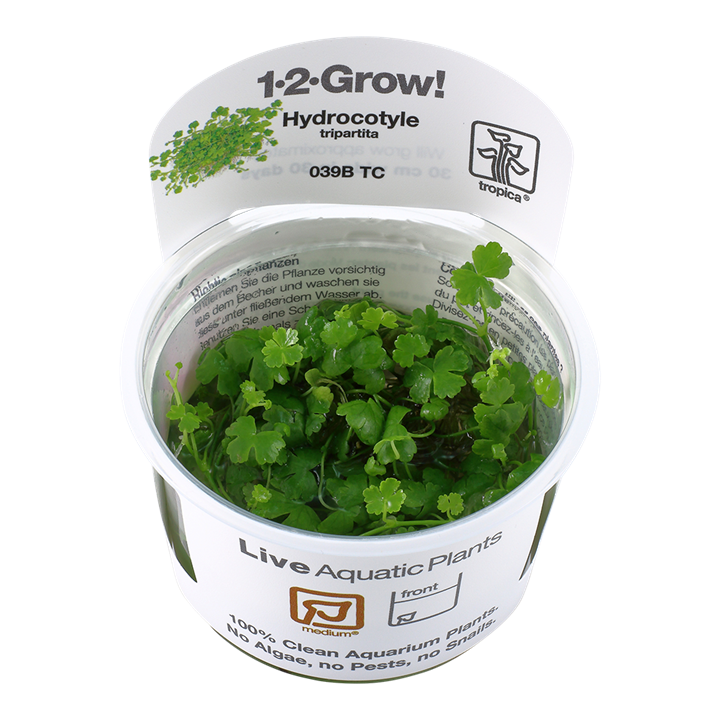


Hydrocotyle sp.”Japan” is the popular name of the plant in different plant forums. It is a variant of Hydrocotyle tripartita from South-East Asia.
It is characterised by fast, compact growth and small, intense green leaves on vertical stems. The plant is carpet-forming (5-10 cm tall) and its compact growth can be promoted by physically pressing the carpet with your hand when maintaining your aquarium (mechanical retardation). Carpet formation and compact growth do best in good light. https://tropica.com/en/plants/plantdetails/Hydrocotyletripartita(039BTC)/18751
Hydrocotyle verticillata Advanced
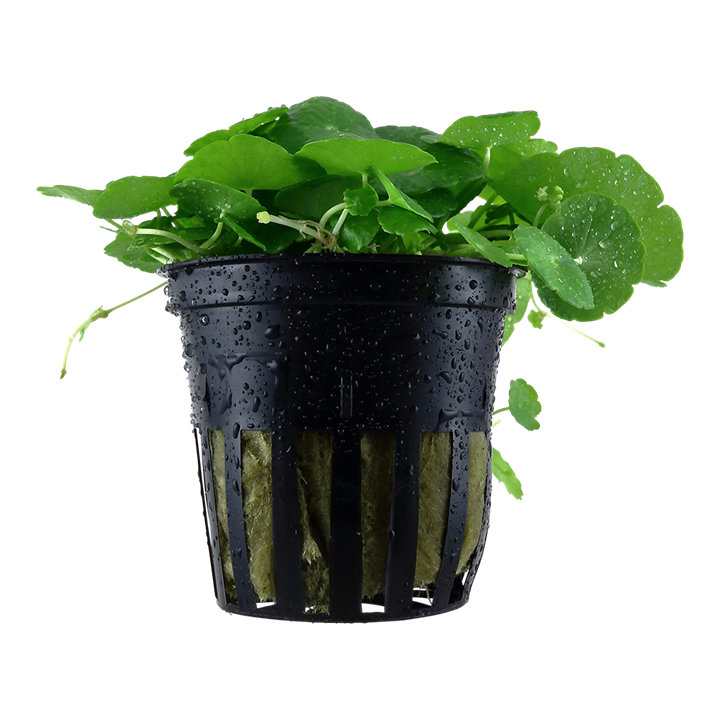
Unlike other Hydrocotyle species, this plant retains its trailing growth form. Verticillata originates from America and becomes 3-7 cm tall. Optimum growth is only achieved in strong light and soft, slightly acidic water. It does not need to be rooted, but can be used as a floating plant.
Hydrocotyle verticillata is definitely a foreground plant, but also suitable for garden ponds. If the soil is kept moist, you may even use it as an indoor plant. https://tropica.com/en/plants/plantdetails/Hydrocotyleverticillata(039)/4457
Hygrophila corymbosa Easy


Hygrophila corymbosa is an undemanding starter plant that originates from Asia. In the aquarium it will spread fast and create bright green, long and wide leaves.
It is a fast growing plant that must be pruned frequently. New shoots will spread from the stem and make the plant look bushier. The cuttings can be re-planted in the bottom of the aquarium where new roots form quickly.
A bundle of stems or young plants gathered in an anchor. Remove the anchor and split into separate plants. Regarding stem plants, remove the leaves from the lowest 5 cm (2“). Remove any damaged leaves. Plant the individual plants with some distance into the bottom substrate. Roots will develop soon and the plant start growing. https://tropica.com/en/plants/plantdetails/Hygrophilacorymbosa(053BDT)/4490
Hygrophila corymbosa ‘Compact’ Easy

A very compact variety of Hygrophila corymbosa, with the leaves set close to the stalk.
Forms numerous side shoots, enhancing the compact appearance. The leaves are a dark brownish-green, when the plant leaves the nursery, but after a transitional period in the aquarium they turn pale green and silver-white on the underside.
In strong light, the newest leaves may become reddish brown and in dimmer light, the oldest ones die away after a while. New side shoots often forms to replace the old ones. https://tropica.com/en/plants/plantdetails/Hygrophilacorymbosa’Compact'(052D)/18774
Hygrophila corymbosa ‘Siamensis’ Easy



‘Siamensis’ originates from Thailand and have stems from 15-40 cm and 10-15 cm wide. Leaves are light green and dense.
Plant several stems in a group at the background of the aquarium, cut off the top shoots when they reach the water surface and replant these. They will soon form new roots and continue growing. In open aquariums Hygrophila corymbosa ‘Siamensis’ grows easily above the water surface, where it forms blue-green leaves and small blue flowers. It grows fast and the shoots should be pinched out regularly if you want to keep the plant under water. An extremely hardy plant, suitable for beginners. https://tropica.com/en/plants/plantdetails/Hygrophilacorymbosa’Siamensis'(053A)/4491
Hygrophila costata Medium


This plant originates from South America and stems become 25-60 cm long with 10 cm long leaves. Under water Hygrophila costata has relatively narrow leaves which are grouped close together. Plants sold in the shops are normally cultivated above water, and have rounder leaves with larger gaps between them.
Hygrophila costata was called Hygrophila corymbosa ‘Angustifolia’ until recently. https://tropica.com/en/plants/plantdetails/Hygrophilacostata(052A)/4489
Hygrophila difformis Easy
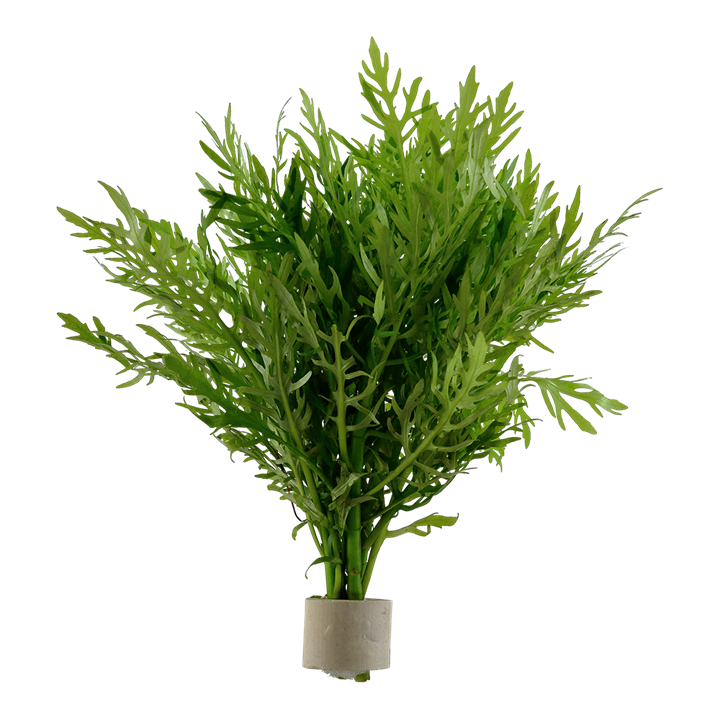

Hygrophila difformis from Asia is beautiful and undemanding stem plant.
Stems becomes 20-30 cm tall and 6-12 cm wide. A plant for beginners, which will help create balance in the aquarium from the start. Its rapid growth helps prevent algae because the plant absorbs a great number of nutrients from the water. The shortage of micronutrients leads to pale leaves, which may be an indication that the aquarium needs fertiliser.
In large aquariums its lobed leaves can create a distinctive group.
A bundle of stems or young plants gathered in an anchor. Remove the anchor and split into separate plants. Regarding stem plants, remove the leaves from the lowest 5 cm (2“). Remove any damaged leaves. Plant the individual plants with some distance into the bottom substrate. Roots will develop soon and the plant start growing. https://tropica.com/en/plants/plantdetails/Hygrophiladifformis(051BDT)/4485
Hygrophila lancea ‘Araguaia’ Medium


“Araguaia” is a river system in Brazil and it is under this name that the plant has become known. There are many signs, however, that the plant is a Hygrophila lancea from Japan and Hong Kong.
The stem becomes 10-20 cm tall and 6-15 cm wide. It has compact, tight-sitting leaves and grows branches easily. Pinching of the stems maintains a bushy look. The colour is reddish brown to purple, promoted by good growth conditions. The growth rate is average for a Hygrophila. https://tropica.com/en/plants/plantdetails/Hygrophilalancea’Araguaia'(051BTC)/4758
Hygrophila pinnatifida Medium



Aquarium plant from tissue culture in closed cup.
Hygrophila pinnatifida originates from India. It obtains brown, patched leaves on the surface with a distinctive burgundy colour underneath. It creates horizontal side shoots and the top shoots should be pinched out in order to maintain compact and attractive growth. The horizontal side shoots easily attach to both wood and rocks. Growth is moderate, stems 15-40 cm tall and 10-20 cm wide, and the colour is attractive when planted in small groups with a plain background. Intense lighting ensures compact growth due to the plant’s slow to medium growth rate. https://tropica.com/en/plants/plantdetails/Hygrophilapinnatifida(051ATC)/19228
Hygrophila polysperma Easy
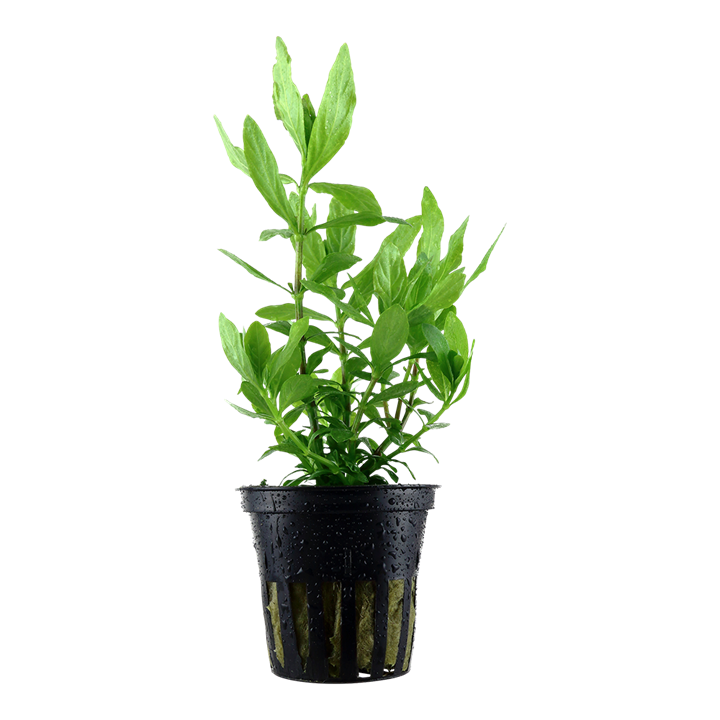

Hygrophila polysperma from South-East Asia is one of the hardiest aquarium plants available. Stems becomes 25-40 cm and 4-8 cm wide.
It is particularly good for beginners because it grows in almost all conditions. It normally grows so fast that it is important to prevent it crowding out other plants. The shoots must be pinched out regularly. Leaves lying on the surface form small new plants.
Hygrophila polysperma varies considerably in leaf shape and colour, depending to some extent on the light supplied. https://tropica.com/en/plants/plantdetails/Hygrophilapolysperma(050)/4483
Hygrophila polysperma ‘Rosanervig’ Easy

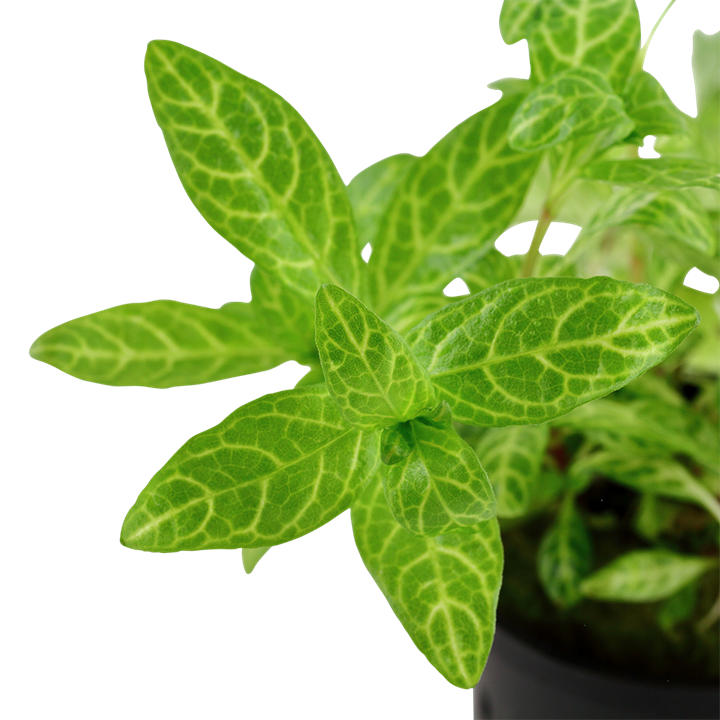

Hygrophila polysperma ‘Rosanervig’ is normally an undemanding plant.
It may suddenly develop shoots that are entirely green. Remove these to keep the distinctive pink, marbled leaves. If you want deep-pink leaves, you must provide intensive light. Stems becomes 20-40 cm tall and 5-8 cm wide.
The distinctive colouring of the pale leaf ribs is probably caused by a virus which prevents chlorophyll from being produced in the cells around the leaf ribs, making them white. However, this virus does not affect other plants in the aquarium. https://tropica.com/en/plants/plantdetails/Hygrophilapolysperma’Rosanervig'(050B)/4484
Juncus repens Medium

Juncus repens originates from swampy areas of south-east North America. This grasslike plant is rather undemanding in cultivation. Under unhindered light and with a good dose of micronutrients, this plant assumes a reddish-brown hue. Under moderate light, it has a pleasant green colour. Its moderate but constant growth makes Juncus repens an easy-to-handle plant. It can be propagated by cuttings like stem plants. https://tropica.com/en/plants/plantdetails/Juncusrepens(133FTC)/28107
Lagenandra meeboldii ‘Red’ Easy

This plant is originally from India and is quite similar to a medium-sized, broad-leaved Cryptocoryne. It can be used in the aquarium like Cryptocorynes, but needs sufficient light to develop colours.
The leaves are 4-8 cm wide and 6-12 cm long, so the whole plant becomes relatively wide.
The colours range from dusty green with bright violet to red-violet often on the same leaf. New leaves are pale pink. https://tropica.com/en/plants/plantdetails/Lagenandrameeboldii’Red'(103)/4759
Leptodictyum riparium Easy


Leptodictyum riparium is a slender, upright moss that tolerates both high and low temperatures. Leptodictyum riparium is often called “stringy moss” and is found throughout most of the world, but is thought to have originated in Europe. It has an intense, slightly transparent green colour. An undemanding and easy moss that can adhere to rocks and tree roots in the aquarium. Growth is both vigorous and rapid, so regular trimming is required.
A generally good plant for beginners who want a unique effect in the aquarium. The moss is popular in nano aquariums, and often used as brood care and cover. https://tropica.com/en/plants/plantdetails/Leptodictyumriparium(003ETC)/28671
Lilaeopsis brasiliensis Easy



Lilaeopsis brasiliensis from South America can grow very compact, but a “lawn effect” (4-7 cm tall) is only achieved at high light intensity. When planting in the aquarium small clumps (approx. 1/8 pot) should be placed a few centimetres apart to help the plants grow together more quickly. Place in an open position without shading from other plants to ensure good light. Lilaeopsis brasiliensis can be used in garden ponds, and also tolerates low salt concentrations in brackish aquariums. https://tropica.com/en/plants/plantdetails/Lilaeopsisbrasiliensis(040TC)/4460
Lilaeopsis mauritiana Medium

This Lilaeopsis species demands less light than Lilaeopsis brasiliensis and stays low (5-10 cm “lawn”). Tropica’s founder, Holger Windeløv, found it on Mauritius in 1992. The plants height and distance between its leaves depend on the light intensity. The more light it gets, the lower the plant and the denser the leaves. The runners spread round the aquarium. To be planted like Lilaeopsis brasiliensis. https://tropica.com/en/plants/plantdetails/Lilaeopsismauritiana(040B)/4461
Lilaeopsis novae-zelandiae Easy


Lilaeopsis novae-zelandiae on grid 9 x 11 cm.
Lilaeopsis Novae-Zelandiae can grow very compact, but a “lawn effect” (4-7 cm tall) is only achieved at high light intensity. When planting the pad in the aquarium, cover the grid entirely with a centimetre of bottom layer material to help the plants grow new roots. Place it away from the shading of other plants to ensure it gets good light. https://tropica.com/en/plants/plantdetails/Lilaeopsisnovae-zelandiae(040AST)/20823
Limnobium laevigatum Easy


Aquarium plant from tissue culture in closed cup.
Limnobium laevigatum from South America is a decorative floating plant that is particularly suitable for open aquariums.
1-5 cm tall and leaves from 5-15 cm wide.
It is also good in traditional aquariums, because the fine, long and decorative roots provide protection to gouramies and other surface fish that like the roots of floating plants. If there are enough nutrients in the water and the light intensity is good, new leaves will appear above the water surface. It may become necessary to remove some to avoid that the plants beneath it still gets some light.
When the nutrient level in the water decreases, it will grow much slower which makes it a great indicator of the available nutrients. https://tropica.com/en/plants/plantdetails/Limnobiumlaevigatum(063TC)/4761
Limnophila aquatica Medium


An extremely beautiful aquarium plant circled by light-green and finely branched leaves from South-East Asia. In the right growing conditions with added CO2 and a nutritious bottom this plant grows fast and can become 25-50 cm long and each stem up to 15 cm wide. In good light it forms horizontal side shoots and becomes attractive and bushy.
Most decorative when several stems are planted in a small group. In open aquariums it sometimes sends shoots above the water surface, forming small blue flowers. https://tropica.com/en/plants/plantdetails/Limnophilaaquatica(046)/4471
Limnophila hippuridoides Easy


Limnophila hippuridoides is originally from Asia and the stalks grow to be 20-50 cm high and 6-10 cm wide – often with beautiful outwards crooked shoot tips. A simple plant, able to adjust to various conditions.
The leaves are green with a red-violet underside, and the whole leaf turns red-violet under ideal growth conditions. A vigorously growing plant that willingly creates new, solid shoots from the base. Thinning of the oldest and longest shoots is recommended, in order to make room for such new shoots. Replant the cut-offs, they will soon grow new roots.
If either stem or leaves are damaged, a strong scent is emitted. https://tropica.com/en/plants/plantdetails/Limnophilahippuridoides(047C)/4474
Limnophila sessiliflora Easy



Limnophila sessiliflora is a pretty and undemanding plant from South-East Asia. A great alternative to Cabomba, which requires a lot of light. Stems grow fast up to 40 cm tall and become 3-4 cm wide. The plant often grows leggy in poor light, but this can be counteracted to some extent by stimulating growth with CO2 addition. Most beautiful when planted in groups. In good growing conditions it sends out runners and spreads across the bottom.
Limnophila sessiliflora used to be called “Ambulia”. https://tropica.com/en/plants/plantdetails/Limnophilasessiliflora(047)/4472
Lindernia rotundifolia Easy

Lindernia rotundifolia ‘Variegated’ grows on sandy banks along streams in Asia. This marbled variant may grow new shoots with entirely green leaves. Cut these shoots off to maintain the marbled aspect. The plant is undemanding and quickly forms compact groups and may require some pruning.
Lindernia rotundifolia is suitable both for background and as a solitary mid-ground plant with leaves growing tightly from top to bottom. A good starter plant that thrives under most conditions. https://tropica.com/en/plants/plantdetails/Linderniarotundifolia(045)/4468
Littorella uniflora Easy


The appearance of Littorella uniflora makes it an easily recognizable plant in the aquarium.
It grows wild on lakeshores of Europe, North America and South America. Tolerates quite low light intensity, but this will add to the length of leaves.
Each rosette is planted separately with a distance of a few cm. They will readily send out runners. In time a very characteristic carpet of fat and fleshy leaves – each 2-5 cm long and 0,1-0,3 cm wide – will be created. Be careful when maintaining the tank, the leaves are easily damaged.
Littorella uniflora is suitable for terrarium and garden ponds, too. https://tropica.com/en/plants/plantdetails/Littorellauniflora(081TC)/18269
Lobelia cardinalis Easy



Lobelia cardinalis grows wild in Northern America. In the nursery this plant is cultivated in marshy conditions, forming dark-green leaves which are purple underneath. In aquariums the leaves turn a beautiful shade of light-green, with stems 10-30 cm tall and 5-10 cm wide.
Widely used in Dutch aquariums in so-called “plant streets”. In open aquariums it grows above the water surface, where it forms very beautiful scarlet flowers and the leaves regain their colour. Can be used in garden ponds. https://tropica.com/en/plants/plantdetails/Lobeliacardinalis(053C)/4494
Lobelia cardinalis ‘Mini’ Easy


Sometimes plants surprise by suddenly deviating from the way they normally grow. This is called a mutation, and Lobelia cardinalis ‘Mini’ is a good example of this. Lobelia cardinalis ‘Mini’ has thus originated from the general production of Lobelia cardinalis. It is characterized by its beautiful light green leaves which are closer together than on the original Lobelia, and then it is also significantly smaller, hence the addition ‘Mini’ to the name of the plant.
The growth is low and dense, as the plant branches willingly, even without trimming. In addition, the mini version rarely forms the long vertical shoots which otherwise characterize Lobelia cardinalis. https://tropica.com/en/plants/plantdetails/Lobeliacardinalis’Mini'(143TC)/28647
Ludwigia glandulosa Medium


Ludwigia glandulosa from North America is a very beautiful water plant.
It is slow growing and requires CO2 addition to grow well. Stems becomes 15-40 cm tall and 5-12 cm wide. The leaves turn greener and the lower ones may fall off if sufficient light is not provided.
Used to be sold as Ludwigia perennis. https://tropica.com/en/plants/plantdetails/Ludwigiaglandulosa(035A)/4452
Ludwigia inclinata ‘Cuba’ Advanced

Ludwigia inclinata ‘Cuba’ was found in Cuba by Tropica founder Holger Windeløv. It is an exceptionally beautiful, large stem plant that requires good space and optimal conditions to develop well. The narrow leaves have a mixture of golden, orange and red colours, creating a unique eye-catcher in any aquarium.
High light intensity combined with good water circulation and abundant fertilisation, including CO2 supply, are essential. Growth is upright, overhanging and vigorous, so regular pruning is necessary. As the plant does not always produce new shoots after pruning, the cut top shoots should be replanted. Remove the lowest leaves and plant the shoot in the soil, where roots will quickly form. https://tropica.com/en/plants/plantdetails/Ludwigiainclinata’Cuba'(035C)/28648
Ludwigia palustris ‘Super Red’ Easy


This cosmopolitan stem plant turns red easier and is smaller than the well-known Ludwigia repens ’Rubin’.
Each stalk becomes 2-4 cm wide and 10-30 cm high. The plant willingly creates side shoots, but cutting increases the amount and the plant becomes even denser. The cut-off shoots quickly generate new roots when planted.
The plant becomes intensely red and grows better, when placed in light and with added CO2. https://tropica.com/en/plants/plantdetails/Ludwigiapalustris’SuperRed'(035B)/4453
Ludwigia repens ‘Rubin’ Easy


Variety of Ludwigia repens from North America with striking dark red leaves and stalk. Stems from 20-50 cm and 4-6 cm wide. It provides a great colour contrast to the green shades in the aquarium. Plant in large groups to enhance the decorative effect, and prune regularly to encourage bushy growth.
The plant has few demands, but if light is insufficient the lower leaves tend to fall off. In strong light the colour becomes more intense. https://tropica.com/en/plants/plantdetails/Ludwigiarepens’Rubin'(033D)/4450
Marsilea crenata Medium
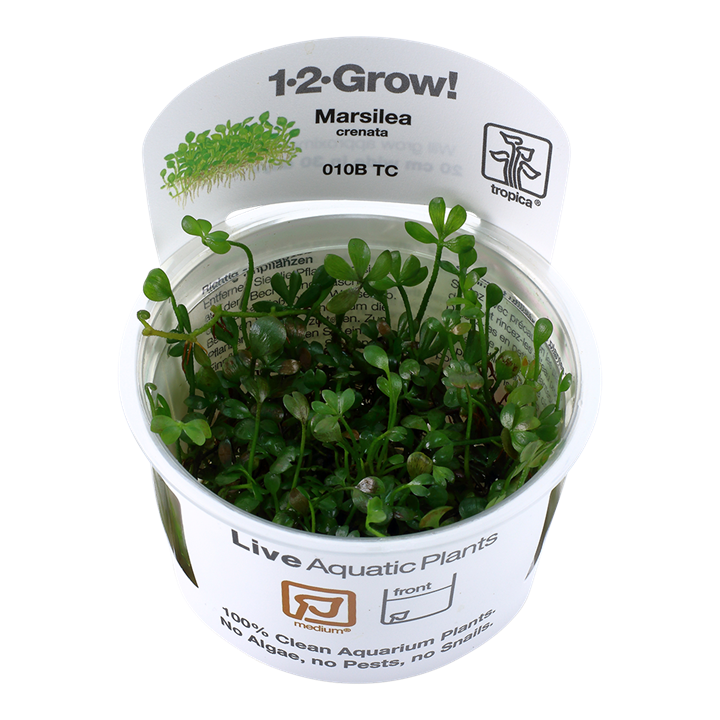


This small fern comes from Asia, where it ofte grows in rice fields. The leaves are tiny and rarely wider than 0.5 cm.
A hardy plant that tolerates poor light conditions and high temperatures. However, improved conditions are beneficial to its development. Planted in small bundles that spread with offshoots. Creates a 1-3cm high and close carpet, well anchored in the bottom layer. https://tropica.com/en/plants/plantdetails/Marsileacrenata(010BTC)/4762
Marsilea hirsuta Easy


Marsilea hirsuta is a carpet-plant from Australia. A fascinating plant, usually delivered with leaves like a four-leaf clover. After a transitional period it develops different types of leaves, possibly a low form with single leaves like a large Glossostigma, or alternatively develop two, three or four-lobed leaves varying in height (from 2-10 cm), depending on the growth conditions. Whichever form the plant adopts, it forms runners and spreads rapidly round the aquarium. https://tropica.com/en/plants/plantdetails/Marsileahirsuta(010TC)/4428
Mayaca fluviatilis Medium


Mayaca fluviatilis is a stem plant from South and Central America. The stem is extremely soft and flexible which, in addition to the very narrow, bright green leaves, gives the plant a light and graceful expression. It branches willingly and the rapid growth makes regular pruning necessary.
This plant prefers soft, slightly acidic water, but it also thrives well in medium hard water.
Mayaca fluviatilis is known to get very pale shoots if it lacks iron.
A bundle of stems or young plants gathered in an anchor. Remove the anchor and split into separate plants. Regarding stem plants, remove the leaves from the lowest 5 cm (2“). Remove any damaged leaves. Plant the individual plants with some distance into the bottom substrate. Roots will develop soon and the plant start growing. https://tropica.com/en/plants/plantdetails/Mayacafluviatilis(140BDT)/19792
Micranthemum tweediei ‘Monte Carlo’ Medium




Micranthemum tweediei ‘Monte Carlo’ originates from Argentina. It has compact, round and fresh light green leaves on creeping stalks and creates a fast-growing carpet in the front of the aquarium.
The plant can grow in light shadow, but requires good light conditions, as well as CO2 additive, in order to develop optimally and become really compact. https://tropica.com/en/plants/plantdetails/Micranthemumtweediei’MonteCarlo'(025TC)/4442
Micranthemum umbrosum Medium


Micranthemum umbrosum on grid 9 x 11 cm.
Micranthemum umbrosum is a beautiful plant from US with small round leaves. It is suitable for small or large aquariums with stems becoming 10-25 cm long and 1-2 cm wide.
Relatively demanding in terms of light. CO2 addition is recommended to promote growth. Once the plant starts growing it grows fast, and the shoots have to be pinched out often (can be planted as cuttings in the bottom). Most beautiful in groups of many stems. https://tropica.com/en/plants/plantdetails/Micranthemumumbrosum(048ST)/19793
Microsorum pteropus Easy


Microsorum pteropus is a water fern from Asia, 15-30 cm tall. To be grown on a root or stone, attached with fishing line until it has gained a hold. If planted in the bottom, do not cover the rhizome because it will rot. Easy to propagate by splitting the horizontal rhizome. A hardy plant that grows in all conditions. The black spots under the leaves are sporangia (reproductive organs), not signs of disease, as many believe. https://tropica.com/en/plants/plantdetails/Microsorumpteropus(008)/4408
Microsorum pteropus ‘Narrow’ Easy

Microsorum pteropus is a highly variable species, and new varieties are easily bred. Microsorum pteropus ‘Narrow’ has narrower leaves, which grow at a less acute angle from the stem than the normal Microsorum pteropus. Leaves becomes 10-20 cm and a rhizome from 10-15 cm or more. The plant attaches readily to roots and stones. A decorative plant, which is also suitable for smaller aquariums. https://tropica.com/en/plants/plantdetails/Microsorumpteropus’Narrow'(008A)/4414
Microsorum pteropus ‘Trident’ Easy


Microsorum pteropus or Java fern is from Asia. Microsorum pteropus ‘Trident’ is a narrow-leaved, smaller form of Microsorum, which like other Microsorum is an easy and safe plant. ’Trident’ is both suitable for beginners, as well as the experienced scaper, and fits both smaller and larger aquariums.
The name ’Trident’ tells that the plant leafs are tripartite, while the leaves can vary from whole to multipartite. Suitable for planting on stones or tree roots. When planted on the bottom layer, avoid covering the horizontal stalk. New, small plants are often created on the leaf tips, and can carefully be pulled off and planted. https://tropica.com/en/plants/plantdetails/Microsorumpteropus’Trident'(008G)/4424
Microsorum pteropus ‘Windeløv’ Easy


Microsorum pteropus ‘Windeløv’ is a patented variety of Microsorum pteropus, named after Tropica’s founder Holger Windeløv. Its finely branched leaf tips make it one of the most beautiful aquarium plants. The Microsorum variety becomes 15-20 cm tall and wide.
A hardy and easy plant for both beginners and the more experienced. Best results are obtained by planting it on a stone or tree root. If planted in the bottom the horizontal rhizome must not be covered. This plant is not eaten by herbivorous fish. https://tropica.com/en/plants/plantdetails/Microsorumpteropus’Windeløv'(008B)/4418
Monosolenium tenerum Easy


The Asian Monosolenium tenerum is an attractive liverwort, 2-5 cm high, which looks most like a giant Riccia that simply stays at the bottom, where it forms cushions.
It is a brittle plant, and pieces break off easily, so it is best to place it in the aquarium attached to stones with fishing line or in small clumps among other plants such as Eleocharis.
Once Monosolenium has established itself, it is very undemanding. This plant is mistakenly known as Pellia. https://tropica.com/en/plants/plantdetails/Monosoleniumtenerum(002CTC)/18747
Murdannia keisak Easy


This bamboo-looking stem plant is not a grass. It comes from Asia, where it often grows in rice fields.
The growth is upright, but the plant branches out willingly when it is cut back.
The leaf is light green, approx. 1cm wide and 3-5cm long. The stem apex becomes reddish when exposed to CO2 and strong light.
Due to quick growth, the longest shoots require ongoing cut back and some of the tops can be replanted, in order to maintain a beautiful and varied group of plants. https://tropica.com/en/plants/plantdetails/Murdanniakeisak(135)/4763
Myriophyllum ‘Guyana’ Medium


This Myriophyllum keeps its bright, green colour even at very high light intensity. Every stem will only measure approximately 2-3 cm (1”), but it branches willingly and the plant quickly becomes dense and lush.
Cutting down is often necessary to maintain the access to light and water flow. Its moderate growth makes Myriophyllum ‘Guyana’ particularly adapted to nano tanks. https://tropica.com/en/plants/plantdetails/Myriophyllum’Guyana'(037ETC)/19549
Myriophyllum mattogrossense Medium



Myriophyllum matogrossense originates from Mato Grosso in the Rio Amazonas, Brazil. It has decorative and feather-like, reddish stems (30-60 cm long) and finely divided bright green leaves (5 cm wide).
In good light conditions the leaves spread out in a fan shape. Myriophyllum is relatively easy and is suitable for the background. It needs frequent trims to maintain its bushy form. It is fast growing and requires a good deal of nutrition.
A good starter plant. https://tropica.com/en/plants/plantdetails/Myriophyllummattogrossense(037TC)/28108
Nesaea crassicaulis Medium


Nesaea crassicaulis from Africa is a beautiful and highly recommended aquarium plant, although it has high light demands. It has red-brown, cognac-coloured leaves. Stems becomes 30-50 cm and 8-15 cm wide. Grows best in soft and slightly acidic water. Make sure the lower leaves get sufficient light or they will die off. This plant is similar to Ammannia species and is often mistaken for them. But in the aquarium it can be recognized by its yellow-green stems. Easy to propagate by side shoots or cuttings which you replant in the bottom. https://tropica.com/en/plants/plantdetails/Nesaeacrassicaulis(033B)/4449
Nymphaea lotus Medium


A beautiful and very varied species from West Africa with leaves of green to red-brown and varying numbers of purple spots. Can grow from 20-80 cm tall. Before forming floating leaves Nymphaea lotus (zenkeri) forms many underwater leaves. If you don’t want floating leaves, prune the roots and leaves.
The beautiful, aromatic flowers can be fully appreciated in open aquariums. A nutritious bottom encourages growth. Often available in a red and a green variety. Recommended as a solitary plant for large aquariums. https://tropica.com/en/plants/plantdetails/Nymphaealotus(019)/4432
Nymphoides hydrophylla ‘Taiwan’ Easy



Nymphoides sp. grows in Asia and Africa – and this variant of the species originates from southern Taiwan. The rosette plant can become 15-25 cm tall and 10-15 cm wide.
This variant is characterized by many underwater leaves and the intense, light-green, transparent colour of the plant. The plant is fast-growing and it is necessary to thin out the leaves (remove oldest leaves and surface leaves).
The plant is easy to care for under varying conditions, but for optimal growth it requires a lot of nourishment. The new plant grows from the plates of old leaves. https://tropica.com/en/plants/plantdetails/Nymphoideshydrophylla’Taiwan'(041BTC)/4463
Phyllanthus fluitans Easy


Originated from the American tropics, Phyllanthus fluitans is a floating plant part of the Phyllanthaceae family.
It is similar to the Salvinia, differentiated only by the mono leave structure on each node. The water repellent, heart shaped leaves hide the stem which can sometimes give life to white flowers with six petals. The more intense the light, the browner the leaves will become. Sustainably cultivated in Denmark. https://tropica.com/en/plants/plantdetails/Phyllanthusfluitans(028TC)/22848
Pogostemon erectus Medium



The Indian Pogostemon erectus forms compact groups of bright green, conifer-like stems, 15-40 cm tall and 1-3 cm wide.
Pogostemon erectus is suitable as a background plant and creates a wonderful focal point in both smaller and larger groups. Intense light helps the plant to stay compact for a longer period. Moderate growth and vigorous roots. Plants will need frequent pruning, and cut off shoots will easily start growing when planted. https://tropica.com/en/plants/plantdetails/Pogostemonerectus(053FTC)/4497
Pogostemon helferi Medium



This plant was discovered by aquarists in Thailand, close to the border with Burma. It is called ‘Downoi’ (little star) in Thailand, and it is easy to see why (5-10 cm tall and wide). Pogostemon helferi is an unusual and distinctive aquatic plant with a compact habit, curly leaves and a strikingly beautiful green colour.
With good light conditions and a substrate rich in nutrients Pogostemon helferi forms many side shoots, which develop small roots, and the plant rapidly forms an impressive carpet of foreground vegetation. https://tropica.com/en/plants/plantdetails/Pogostemonhelferi(053HTC)/19680
Pogostemon stellatus Advanced


Pogostemon stellata from Asia and Australia is distinguished by its beautiful shape and colour. Stems from 20-60 cm and up to 10 cm wide. It is difficult to grow in aquariums. It requires intensive light and the addition of CO2 to grow well.
The shortage of micronutrients leads to pale leaves, which may be an indication that the aquarium needs fertiliser. Even in good conditions growth sometimes stops suddenly. Plants in aquarium shops are generally low, compact plants grown in marshy conditions, and do not reveal their full glory until planted in the aquarium. https://tropica.com/en/plants/plantdetails/Pogostemonstellatus(053G)/4498
Proserpinaca palustris ‘Cuba’ Advanced


Proserpinaca is a stem plant, 10-40 cm tall and 5-10 cm wide.
Cultivated in closed cups and delivered with saw-toothed leaves, which after a transitional period in the aquarium develop into long, finely denticulated, needle-like leaves.
In good light conditions it turns a beautiful copper colour and its characteristic appearance is a pleasing contrast to the other plants.
Proserpinaca palustris varies in form according to its origin. The Tropica cultivar is found on the Isla de la Juventud off Cuba. In the USA the plant is commonly known as “mermaid weed’’ https://tropica.com/en/plants/plantdetails/Proserpinacapalustris’Cuba'(037CTC)/4766
Ranunculus inundatus Medium


This species comes from Australia and becomes 5-10 cm tall. There are many species and variants of Ranunculus, which grow coarse and leggy in aquariums. Ranunculus inundatus is characterised by its compact form and distinguished, deeply cut umbrellas. The plant forms many vertical runners with new plants and over time thick bottom coverage is formed. Good lighting produces compact growth. Long leaves can be pruned. https://tropica.com/en/plants/plantdetails/Ranunculusinundatus(022CTC)/18225
Riccia fluitans Medium


Aquarium plant from tissue culture in closed cup.
Japanese Takashi Amano has inspired many aquarium owners to keep the 1-5 cm tall cosmopolitic liverwort, Riccia fluitans, submerged. It can be kept down by tying it to a stone with a piece of fishing line, but new shoots always grow towards the surface, so it may be necessary to prune it with scissors. Riccia fluitans thrives best with added CO2 and in good growing conditions small oxygen bubbles form on the leaf tips. As a traditional floating plant it offers good protection for young fish. https://tropica.com/en/plants/plantdetails/Ricciafluitans(001TC)/4386
Rotala indica ‘Bonsai’ Medium



Rotala indica ‘Bonsai’ is best described as a compact, moderate growing version of Bacopa caroliniana.
Plant it in small groups and trim it often. Cuttings may be re-planted in the group to achieve a more dense group or carpet.
At high light the tip of the stems may become reddish, at lower light the leaves will become larger and the plant less compact.
Rotala ‘Bonsai’ is particularly suitable for nano-aquariums. https://tropica.com/en/plants/plantdetails/Rotalaindica’Bonsai'(033ETC)/4451
Rotala macrandra Advanced


Rotala macrandra ‘Japan’ is a magnificent aquarium plant, but unfortunately, it is very demanding. This variant is a little easier to grow and develops better coloration. It needs very good light to develop its beautiful red shades, just like CO2 addition and soft water are vital to ensure optimal growth.
Cut the longest stems 5-10 cm from the ground and replant them in the group. https://tropica.com/en/plants/plantdetails/Rotalamacrandra(032TC)/4445
Rotala rotundifolia Easy



The Latin name means “the plant with the round leaves”, but this only applies to the marsh variety, which has circular leaves. Rotala rotundifolia from South-East Asia has 15-30 long stems (2-3 cm wide) and long, narrow leaves. Unlike other Rotala species it is relatively undemanding, although it needs good light to produce red leaves.
It forms side shoots willingly, becoming compact and bushy. This also means that it is hard for light to reach the lower leaves, so the plant should be pruned frequently. Also known as Rotala indica. https://tropica.com/en/plants/plantdetails/Rotalarotundifolia(033)/4447
Rotala rotundifolia ‘H’ra’ Medium
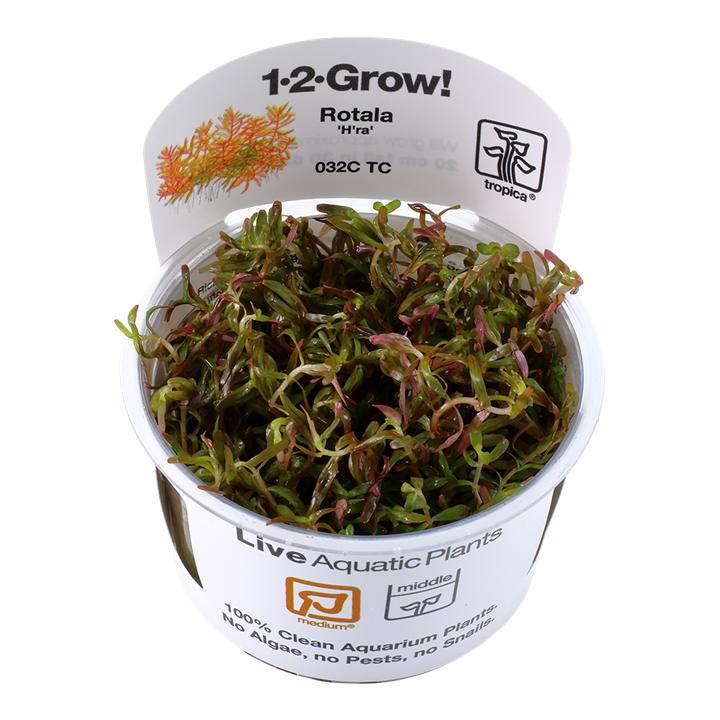

Aquarium plant from tissue culture in closed cup.
Rotala ‘H’ra’ has rather narrow leaves and an overhanging or creeping growth. It is probably a variation of Rotala rotundifolia and has much resemblance to Rotala sp. ‘Green’.
High light levels, good fertilization and added CO2 will induce almost exclusively creeping growth and a warm, rich orange coloration. This makes it possible to create a dense, orange mid-ground cushion or even an unusual, orange foreground carpet. https://tropica.com/en/plants/plantdetails/Rotalarotundifolia’H’ra'(032CTC)/19550
Rotala wallichii Advanced
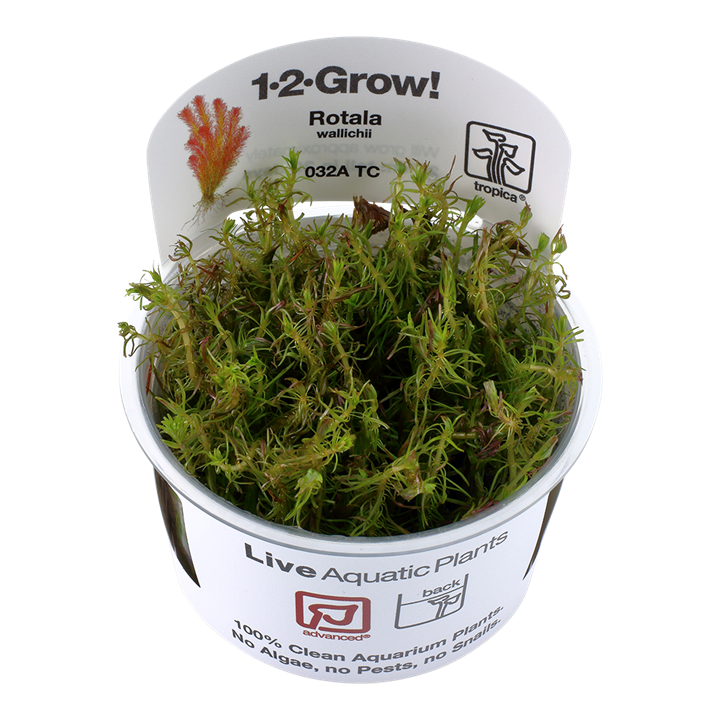

Aquarium plant from tissue culture in closed cup.
Rotala wallichii is a demanding plant that develops red shoot tips in good light conditions.
The most decorative effect can be achieved by planting a large number of stems in a group. Rotala walichii is good as background and midground plant and suitable even for small aquariums, because it is easy to prune if it grows too tall. CO2 addition boosts growth considerably. It also prefers soft, slightly acidic water. https://tropica.com/en/plants/plantdetails/Rotalawallichii(032ATC)/18748
Sagittaria subulata Easy



Sagittaria subulata from South America is an ideal, undemanding foreground plant whose short runners form a compact group. Place individual plants 2-4 cm apart. This plant may cause problems because in certain conditions it suddenly grows to a height of 50 cm when it grows older. But if it is then moved into the background it may become low again. In the aquarium it sometimes sends a long flower stem to the surface, and small white flowers unfold just above the water surface. https://tropica.com/en/plants/plantdetails/Sagittariasubulata(079TC)/18270
Salvinia auriculata Easy


Salvinia auriculata is a cosmopolitan floating fern, 1-3 cm that grows quickly if there is sufficient nutrition and light. Light leaves are a sign of a shortage of micronutrients. It tends to shade light from the plants at the bottom. Salvinia varieties have small hairs on their leaves, making them water resistant.
Helps prevent algae by shading parts of the aquarium and using nutrients in the water. Grows very big in the wild and in optimum conditions. A decorative plant for open aquariums. https://tropica.com/en/plants/plantdetails/Salviniaauriculata(011TC)/4767
Shinnersia rivularis ‘Weiss-Grün’ Medium
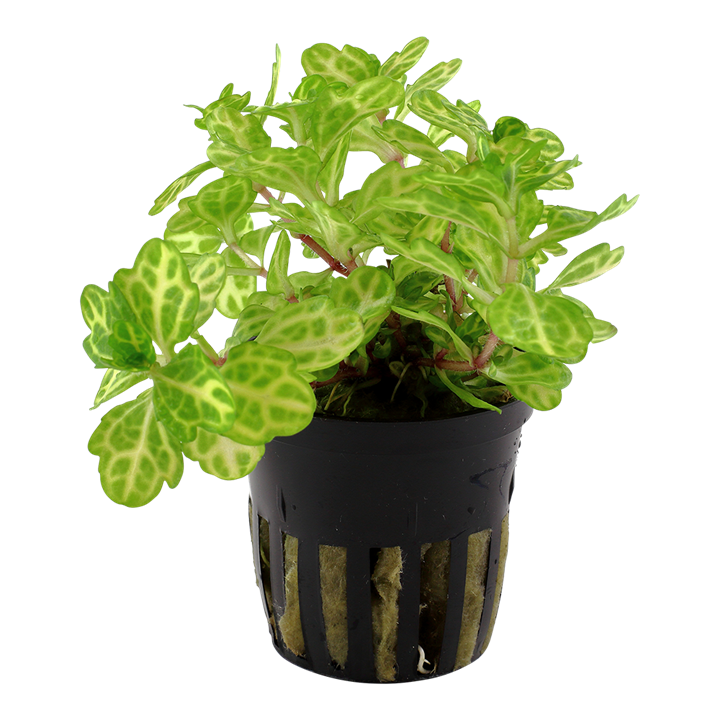

Variety of Shinnersia rivularis, distinguished by the white veins on the leaves, 30-60 cm long and up to 10 cm wide stems. This colour mutation was discovered at the Dennerle aquarium plant nursery.
The plant grows rapidly and soon reaches the water surface, but shoots can simply be pinched off and planted back in the bottom. Shinnersia does not appreciate high temperatures. It tends to become leggy, but several plants placed in a group, will improve the appearance. The colours will develop optimally at good light conditions. https://tropica.com/en/plants/plantdetails/Shinnersiarivularis’Weiss-Grün'(053E)/4495
Staurogyne repens Easy


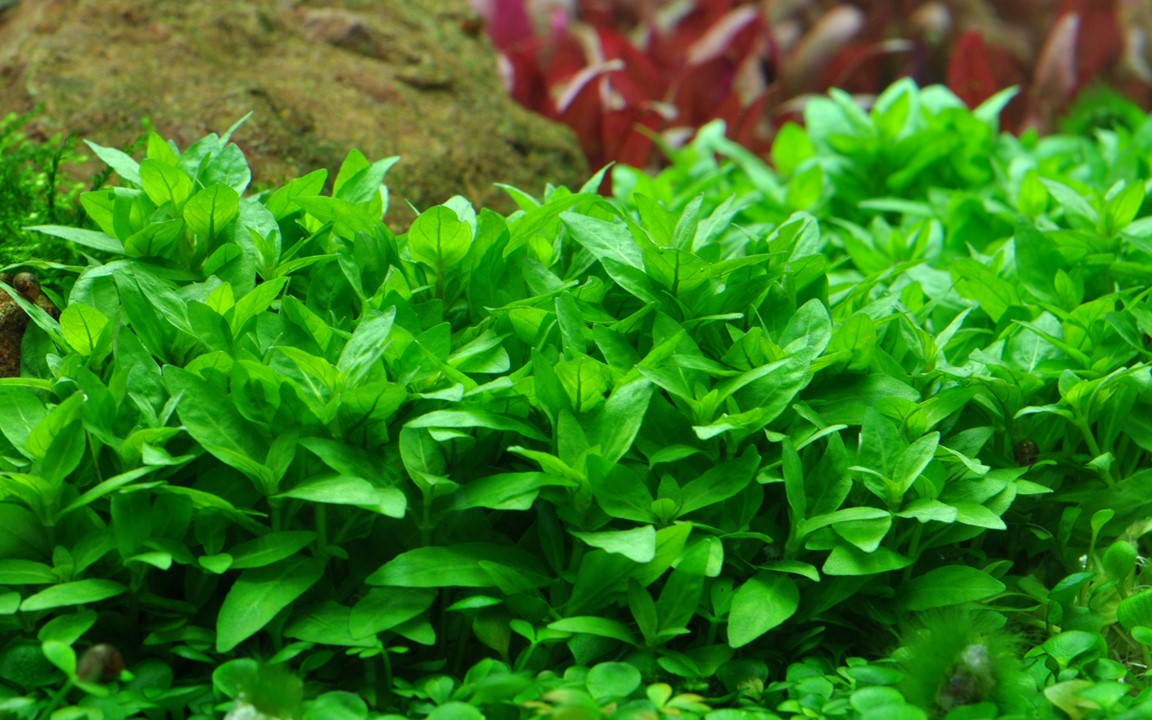
Staurogyne repens is a fresh green, compact and hardy plant for the foreground of the aquarium and it was found in River Rio Cristalino in the southern Amazonas. Its nearest relative in the aquaristic is Hygrophila but Staurogyne is different with its marked compact, low and bushy stature (5-10 cm) and small green leaves (each stem is 3.4 cm wide).
When planting in the aquarium, the longest upright shoots should be cut off and new, horizontally creeping shoots will soon form from the plant basis and gradually colonize the gravel.
At low light, the growth will be more upright and much less side shoots will be formed. https://tropica.com/en/plants/plantdetails/Staurogynerepens(049GTC)/4482
Taxiphyllum alternans ‘Taiwan’ Easy

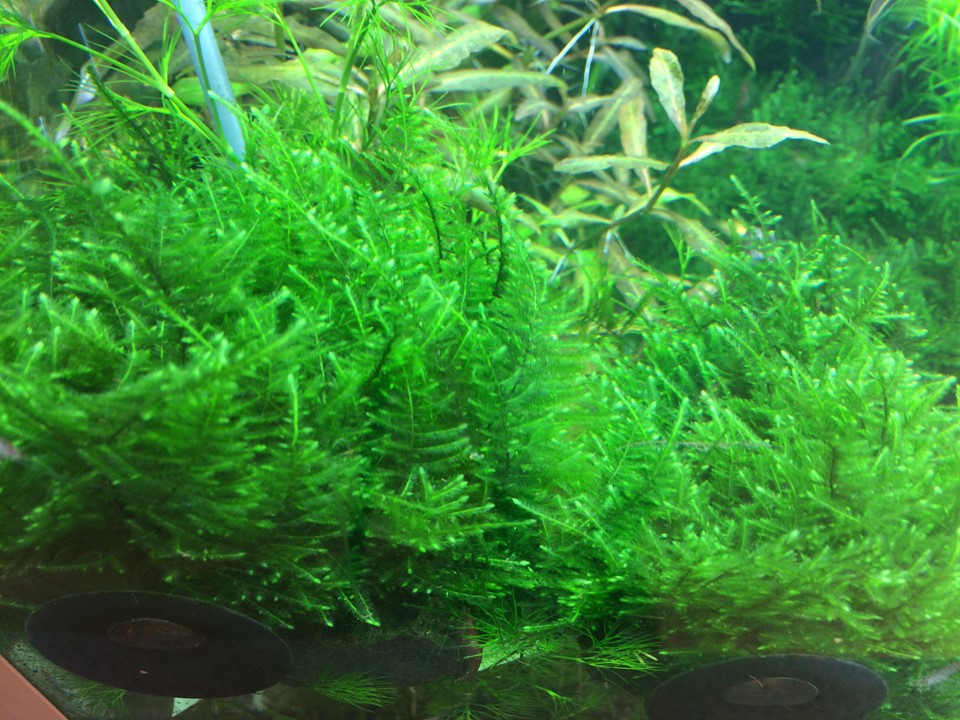
Growth of Mini Taiwan moss is horizontal and overhanging, like a mini version of ‘Weeping moss’. Attaching to branching wood or vertical rock will present it at its best and is also very useful for a moss wall or for hiding installations in the aquarium.
It is an easy and decorative moss with quite low demands, but good light and some added CO2 will promote growth and branching.
Full identity of this beautiful moss is not yet established and studies may likely place it as a species of family Isopterygium. https://tropica.com/en/plants/plantdetails/Taxiphyllumalternans’Taiwan'(003CTC)/19551
Taxiphyllum barbieri Easy


Aquarium plant from tissue culture in closed cup.
Taxiphyllum barbieri from South-East Asia is a hardy plant which makes few demands on the water or light. The moss becomes 3-10 cm thick and grows willingly on any surface, so it is ideal for decorating stones and tree roots or concealing installations in the aquarium. Attach the plant with a piece of fishing line or cotton thread until it has gained a hold on the décor. If its growth becomes too luxuriant, it can be pruned with scissors. In breeding aquariums Taxiphyllum barbieri is a wonderful hiding place for the young fish. https://tropica.com/en/plants/plantdetails/Taxiphyllumbarbieri(003TC)/4393
Taxiphyllum ‘Flame’ Medium


Aquarium plant from tissue culture in closed cup.
Asian Flame moss got its name from its form of growth. Tight, vertical and softly undulating shoots give the impression of a deep green campfire, 5-15 cm high. The special shape makes Flame moss very suitable for horizontal surfaces and it only spreads slowly horizontally.
Attach the moss to small stones or in small bundles on tree roots to obtain a lovely effect. https://tropica.com/en/plants/plantdetails/Taxiphyllum’Flame'(003HTC)/4403
Taxiphyllum ‘Spiky’ Easy



Aquarium plant from tissue culture in closed cup.
‘Spiky’ is Asiatic and grows 2-10 cm tall. Best described as Christmas moss’ big brother, it is bigger and forms many deep green, branched shoots. Spiky moss does best on vertical surfaces where the branched shoots will show. A beautiful carpeting effect is possible if you plant small tufts into the bottom substrate with a small interspace. It grows fast and thrives at a very low light intensity. https://tropica.com/en/plants/plantdetails/Taxiphyllum’Spiky'(003GTC)/18271
Utricularia graminifolia Advanced


Utricularia graminifolia from Asia belongs to the bladderwort family. All the plants in this family are insect eating, perennial water and marsh plants. In the nature, the plant lives in nutrient-poor places, hence the need to catch small insects and digest them.
Bladder traps are a unique feature of this family, which Utricularia graminifolia forms after a short period in the aquarium.
The species name means ‘with grass like leaves’ and the fresh green leaves will after some time form a pretty mat which looks like a lawn (2-8 cm tall).
Utricularia graminifolia is therefore an ideal foreground plant, although it is rather demanding. https://tropica.com/en/plants/plantdetails/Utriculariagraminifolia(049BTC)/4480
Vallisneria americana ‘Asiatica’ Easy


Vallisneria sp. Asiatica has twisted, green leaves that make a beautiful contrast when planted in groups. Its shorter leaves (20-30 cm) differ from most other Vallisneria species and do not overshadow other plants in the aquarium. An easy plant that readily propagates via runners.
A bundle of stems or young plants gathered in an anchor. Remove the anchor and split into separate plants. Regarding stem plants, remove the leaves from the lowest 5 cm (2“). Remove any damaged leaves. Plant the individual plants with some distance into the bottom substrate. Roots will develop soon and the plant start growing. https://tropica.com/en/plants/plantdetails/Vallisneriaamericana’Asiatica'(056ABDT)/4504
Vallisneria americana ‘Gigantea’ Easy


Vallisneria sp. Gigantea from Asia is an easy plant that grows fast, suitable for large aquariums. In most aquariums the leaves grow so long that they float on the surface (50-150 cm, 2 cm wide). So the plant needs pruning to stop it taking too much light from plants growing beneath. The leaves are tough and strong, so they are not normally eaten by herbivorous fish.
Vallisneria americana easily propagates through runners, which are prolific if the bottom is nutritious. https://tropica.com/en/plants/plantdetails/Vallisneriaamericana’Gigantea'(054)/4501
Vallisneria americana ‘Natans’ Easy
Vallisneria sp. ‘Natans’ from Asia is a hardy plant for beginners. It has fine, narrow leaves (50-100 cm long, 1 cm wide) so it does not overshadow other plants much. Easy to propagate using its many runners.


A bundle of stems or young plants gathered in an anchor. Remove the anchor and split into separate plants. Regarding stem plants, remove the leaves from the lowest 5 cm (2“). Remove any damaged leaves. Plant the individual plants with some distance into the bottom substrate. Roots will develop soon and the plant start growing. https://tropica.com/en/plants/plantdetails/Vallisneriaamericana’Natans'(055BDT)/4502
Vallisneria nana Easy


Vallisneria nana from Australia is a solitary contrast plant with dark green, rosulate, narrow leaves (less than 1 cm). It is extremely suitable as a mid-ground plant, but can also be used as a background plant in small aquariums. The leaves are much narrower than with other species of Vallisneria, nor are they quite as long.
Vallisneria nana produces offshoots very readily, so compact vegetation will soon develop in good conditions. https://tropica.com/en/plants/plantdetails/Vallisnerianana(056C)/4505
Vallisneria spiralis ‘Tiger’ Easy


Vallisneria spiralis ‘Tiger’ from Asia is an excellent plant for beginners, growing in virtually all light and water conditions.
The name ‘Tiger’ is due to its striped leaves (30-50 cm long, 1-2 cm wide). The relatively short leaves makes it suitable for small aquariums, and the leaves are also narrow, meaning they do not overshadow smaller plants. Forms runners easily, and is thus easy to propagate. https://tropica.com/en/plants/plantdetails/Vallisneriaspiralis’Tiger'(055A)/4503
Vesicularia ferriei ‘Weeping’ Medium

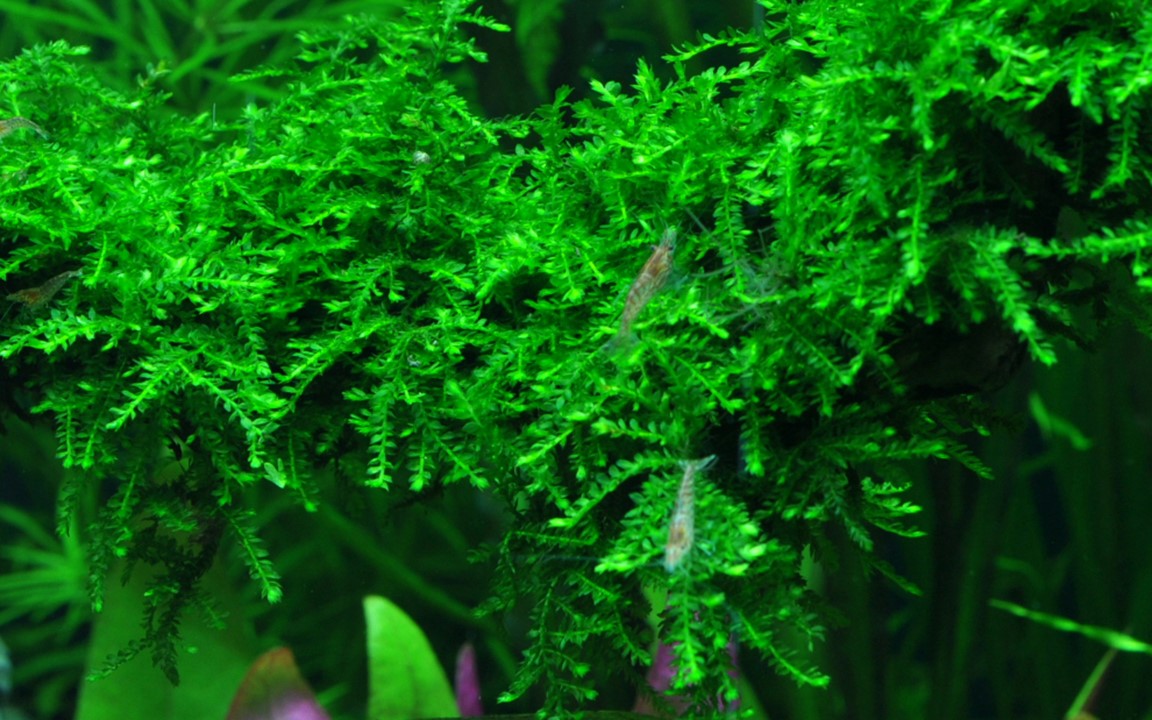
Aquarium plant from tissue culture in closed cup.
Vesicularia ferriei ‘Weeping’, commonly known as Weeping Moss, is believed to originate from China and has been distributed by Oriental Aquarium Plants. ‘Weeping’ is a fleshy, 1-3 cm tall hanging moss with teardrop-like bright green shoots. It is best attached to driftwood or roots, as its drooping growth pattern helps to create depth and contrast in the aquarium. ‘Weeping’ has low demands, is fast growing and should be pruned frequently with scissors to maintain an attractive shape. https://tropica.com/en/plants/plantdetails/Vesiculariaferriei’Weeping'(003BTC)/4399
Vesicularia montagnei ‘Christmas’ Medium


Aquarium plant from tissue culture in closed cup.
A moss speciality from Brasil, 1-3 cm tall, called “Christmas tree moss”, because of its side branch structure which distinguishes it from ordinary Vesicularia dubyana and looks like fir tree branches. It is more demanding than ordinary Java moss and grows more slowly. It attaches readily to roots and stones, and as it spreads in the water it needs pruning to keep its shape attractive. See also Taxiphyllum barbieri. https://tropica.com/en/plants/plantdetails/Vesiculariamontagnei’Christmas'(003ATC)/4396
For more Inspiration and tanks you can view using these aquariums see. https://sevenports.com/2021/11/25/aquascaper-aquariums-inspiration-for-planted-rimless-aquarium-setups/
If you have decided on some the advanced species and need the best regulators available see the Hydra Aquatics Regulators like the one https://sevenports.com/product/hydra-aquatics-compact-pro-co2-regulator-dual-stage/
